

What is a Sloop? Definition, Types and History
A sloop is a type of sailboat that has a single mast and a fore-and-aft rig.
Sloops are a type of sailboat that has been around for centuries. They are known for their versatility and ease of handling, making them popular among sailors of all skill levels. Sloops have a single mast and a fore-and-aft rig that allows for efficient sailing in a variety of wind conditions, making them an excellent choice for both cruising and racing.
Sloops are designed to be easy to handle, even for novice sailors. The simple rigging system means that there are fewer lines to manage than on other types of sailboats, which makes it easier to focus on sailing the boat. This simplicity also means that sloops require less maintenance than other boats, which can save you time and money in the long run.
One of the great things about sloops is how versatile they are. They can be used for everything from day sailing to long-distance cruising to racing. Their design allows them to sail efficiently in a wide range of wind conditions, from light breezes to strong winds. This versatility makes them an excellent choice for sailors who want a boat that can do it all.
The Versatile and Popular Sloop Sailboat Rig
Single mast and fore-and-aft rig.
A sloop is a type of sailboat that has a single mast and a fore-and-aft rig. This means that the sails are positioned parallel to the length of the boat, making it easier for sailors to control the direction of the boat. The simplicity and versatility of the sloop rig make it one of the most popular sailboat rigs in use today.
Mainsail and Headsail
The mainsail is the largest sail on a sloop, and it is attached to the mast and boom. It provides power to move the boat forward. The headsail, which is also known as a jib or genoa, is attached to the forestay and helps to control the boat’s direction by creating lift. Together, these two sails work together to provide speed and maneuverability.
A sloop is typically crewed by one or two sailors, although larger sloops may require more crew members to handle the sails and other equipment. The size of a sloop can vary greatly, from small dinghies used for recreational sailing to large ocean-going vessels used for racing or long-distance cruising.
Variations of Sloops
Bermuda-rigged sloop.
The Bermuda-rigged sloop is a classic design that has been around for centuries. It features a mainsail and a jib, which is a type of headsail. This design is popular among sailors because it is easy to handle and provides good performance in a wide range of wind conditions.

One of the advantages of the Bermuda rig is that it allows for more headsails to be used than other types of rigs, such as ketches or schooners. This means that sailors can adjust their sails to match changing wind conditions, giving them greater control over their sailing vessel.
Another advantage of the Bermuda rig is its simplicity. The sail plan is relatively easy to set up and maintain, making it an ideal choice for beginners or those who prefer a minimalist approach to sailing.
Gunter-Rigged Sloop
The Gunter-rigged sloop is another traditional design that has been around for centuries. It features a mainsail and a jib, but instead of using a masthead rig like the Bermuda sloop, it uses a gaff rigged mast with an additional spar called the gaff topsail.
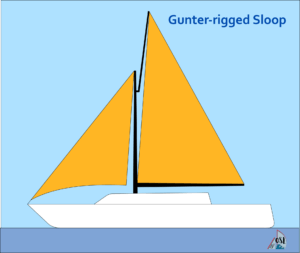
This design was popular in the 19th century because it allowed sailors to carry more sail area without having to use taller masts. However, it fell out of favor in the early 20th century when newer designs were developed that provided better performance.
Despite this, there are still some sailors who prefer the Gunter rig because of its traditional look and feel. It can also be easier to handle than some other types of rigs because the sails are smaller and lighter.
Gaff-Rigged Sloop
The gaff-rigged sloop is similar to the Gunter rig in that it uses a gaff rigged mast with an additional spar called the gaff topsail. However, it also features a headsail like the Bermuda rig.

In the past, boats commonly used gaff rigged sails, but now they have mostly been replaced by Bermuda rig sails. These newer sails are simpler than the gaff rig and allow boats to sail closer to the wind.
Spritsail Sloop
The spritsail sloop is one of the simplest rigs available. It features a single sail called the spritsail, which is attached to a spar called the sprit. This design was popular among fishermen and other working boats because it was easy to set up and maintain.

Although not as popular as before, some sailors still prefer the simplicity of a spritsail rig. It’s a great option for those who want to focus on sailing without the added complexity of multiple lines or sail plans. This type of rig is also suitable for beginner sailors and those who want an easy-to-handle boat.
The Origin of the Word Sloop
The word “sloop” is believed to have originated from the Dutch word “sloep”, which means a small boat used for fishing or transportation. The Dutch were known for their seafaring skills and had a significant influence on maritime culture in Europe during the 17th century. As such, it’s no surprise that many nautical terms used today have Dutch origins.
In fact, the sloop was initially developed in Holland during the 16th century as a small, single-masted vessel used primarily for fishing and coastal trading. These boats were highly maneuverable and could navigate shallow waters with ease, making them ideal for use in Holland’s many canals and waterways.
As Dutch sailors began to explore further afield, they brought their sloops with them, using them as auxiliary vessels to transport goods and personnel between larger ships and shore. Over time, sloops evolved into larger vessels capable of longer voyages and more extensive cargo capacity.
History of Sloops
Sloops have been a popular type of ship for centuries, with their unique rigging and hull design allowing for greater speed and maneuverability compared to other vessels. Let’s take a closer look at the history of sloops and how they have evolved over time.
17th Century: The Birth of Sloops
Sloops first emerged in the 17th century as small, fast ships used for coastal trading and piracy. Their single mast and fore-and-aft sail plan allowed them to navigate shallow waters with ease, making them ideal for smuggling goods or evading authorities. Despite their reputation as pirate ships, sloops were also used by legitimate traders due to their speed and efficiency.
18th Century: Sloops in War
In the 18th century, sloops became increasingly popular among naval forces due to their speed and agility. The British Royal Navy used sloops as dispatch vessels and reconnaissance ships during times of war. Pirates and privateers also favored sloops due to their ability to outrun larger vessels. As a result, the term “sloop-of-war” was coined to describe a small warship with a single mast and crew of around 75 men.

19th Century: Racing Sloops
The 19th century saw the rise of yacht racing, with sloops becoming a popular choice among sailors due to their versatility and ease of handling. In fact, the first recorded yacht race took place in 1826 between two sloops on the Hudson River. Sloops continued to be used for racing throughout the century, with improvements in rigging and hull design leading to faster vessels.
Modern Times: Versatile Sloops
Today, sloops are still widely used for racing and cruising due to their versatility. They are often chosen by recreational sailors who want an easy-to-handle vessel that can navigate both shallow coastal waters and open seas. Modern sloops come in various sizes, from small day-sailers to larger cruising boats. Some sloops even incorporate multiple masts, such as the ketch rig , which features a smaller mizzen mast behind the main mast.
Advantages of a Sloop
Single mast: easier to handle and maneuver.
Sloops are popular sailboats that have a single mast, which makes them easier to handle and maneuver compared to other sailboat types. The simplicity of the sloop rig means that it requires less maintenance and is generally less expensive to maintain compared to other sailboat types. With only one mast, there are fewer lines and sails to manage, making it easier for sailors who are new to sailing or those who prefer a simpler setup.
The single mast design also allows for better visibility on the water since there is no obstruction from multiple masts or rigging. This feature is especially useful when sailing in crowded waters where you need to keep an eye out for other boats or obstacles.
Faster Sailing and Closer to the Wind
Another advantage of sloops is their speed. Sloops are generally faster than other sailboat types due to their streamlined design with fewer sails. The Bermuda sloop, for example, has a triangular mainsail and one or more headsails, allowing it to move quickly through the water with minimal drag.
Sloops can also sail closer to the wind than most other sailboats. This means they can tack (sail against the wind) more efficiently, allowing them to cover more ground in less time. The ability of a sloop’s sails to be adjusted easily helps in this regard as well.
Wide Variety Available
As the most popular contemporary boat, sloops are available in a wide variety. They come in different sizes and designs suitable for various purposes such as racing, cruising, or day sailing. Some sloops even have additional sails like mizzenmast or more headsails which make them more versatile.
For instance, some sloops have a mizzenmast located aft of the mainmast which provides additional support for larger boats during heavy winds. Other sloops may have multiple headsails that allow them greater flexibility when adjusting to different wind conditions. These additional sails can make a sloop more expensive to maintain, but they also provide greater versatility and options for the sailor.
Disadvantages of a Sloop
Limited sail options in heavy weather conditions.
Sloops are known for their simplicity and ease of handling, but they have some disadvantages that sailors should be aware of. One of the biggest drawbacks is the limited sail options in heavy weather conditions. Sloops typically have a single forestay that supports the mast, which means that they can only fly one headsail at a time. This can be problematic when sailing upwind in strong winds or heavy seas.
In these conditions, it’s often necessary to reduce sail area to maintain control and prevent damage to the boat or rigging. With a sloop, this usually means taking down the headsail and relying on the mainsail alone. While this can work well in moderate wind conditions, it may not provide enough power or stability in stronger winds.
Difficulty in Handling Larger Sails Alone
Another disadvantage of sloops is that they can be difficult to handle when sailing with larger sails alone. As mentioned earlier, sloops rely on a single forestay to support the mast and headsail. When you increase the size of the sail, you also increase the load on the forestay and rigging.
This means that you may need additional crew members to help manage larger sails safely. If you’re sailing solo or with a small crew, this can make it challenging to get the most out of your boat without putting yourself at risk.
Higher Loads on Mast and Rigging Due to Single Forestay Design
The single forestay design used by sloops also puts higher loads on both the mast and rigging compared to other sailboat designs. The forestay is responsible for supporting not only the headsail but also part of the mast itself.
This means that any stress placed on the headsail or rigging will be transferred directly to the mast through this single point of attachment. Over time, this can lead to fatigue and wear on both the mast and rigging components.
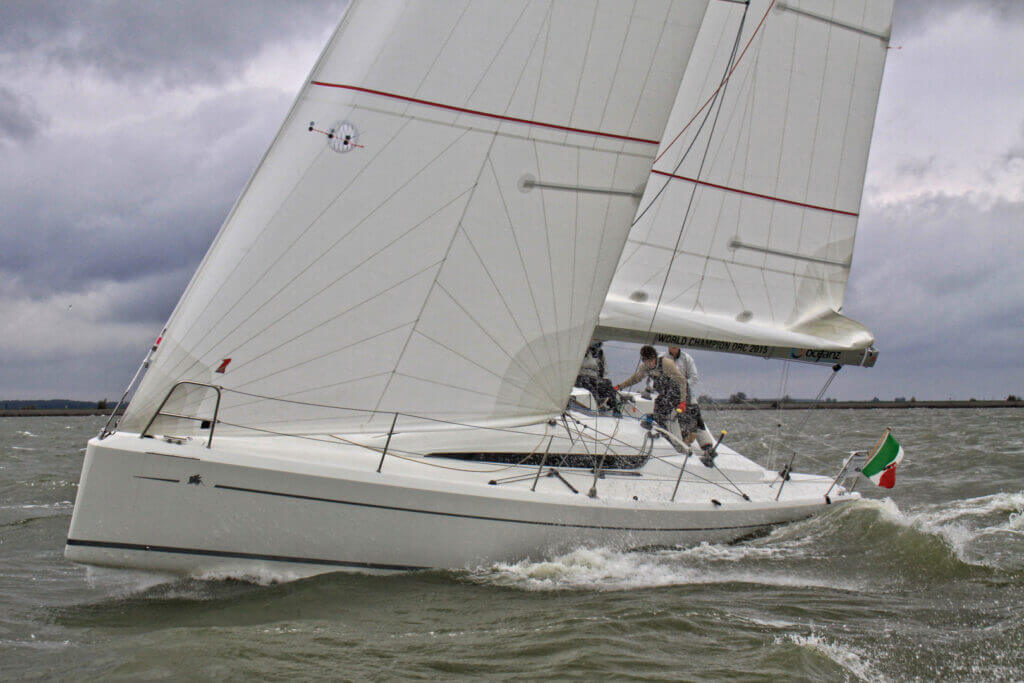
Increased Risk of Broaching in Strong Winds
Sloops are also more prone to broaching in strong winds compared to other sailboat designs. Broaching occurs when a boat is hit by a large wave or gust of wind from the side, causing it to heel over and potentially capsize.
Because sloops have a smaller cockpit and rely on a single forestay for support, they may be more susceptible to this type of event. This can be especially dangerous if you’re sailing in rough conditions or offshore where rescue may not be immediately available.
Reduced Stability Compared to Other Sailboat Designs
Another disadvantage of sloops is that they offer reduced stability compared to other sailboat designs. Sloops typically have a narrower beam and less ballast than other boats of similar size, which can make them feel less stable in heavy seas or choppy water.
This lack of stability can also affect your ability to maintain course and steer accurately, especially when sailing upwind or in challenging conditions. It’s important to understand the limitations of your boat and adjust your sailing style accordingly.
Conclusion: What is a Sloop?
With just one mast and a fore-and-aft rig, sloops are known for their simplicity and versatility. These characteristics make them an excellent choice for sailors of all levels. Whether you’re a seasoned sailor or just starting out, you’ll find that the design of a sloop allows for easy handling and maneuverability.
The single mast on a sloop is typically located towards the front of the boat. This placement provides several advantages when sailing upwind, the sail can be adjusted easily to maintain an optimal angle with respect to the wind. This is because there is only one sail to worry about, unlike other types of boats that may have multiple sails.
Similarly, when sailing downwind, a sloop’s sail can be adjusted quickly to take advantage of any changes in wind direction or speed. This flexibility makes it possible to navigate challenging weather conditions with ease.
External Links, See Also
For those looking for more technical information on sloops and other types of sailboats, the Boatdesign.net forum is an excellent resource. Here you can find discussions on everything from mast design to hull construction.
Finally, if you’re looking for some great books on sailing and sailboat design, be sure to check out “The Elements of Seamanship” by Roger C. Taylor or “Sailing Alone Around the World” by Joshua Slocum.
Similar Posts
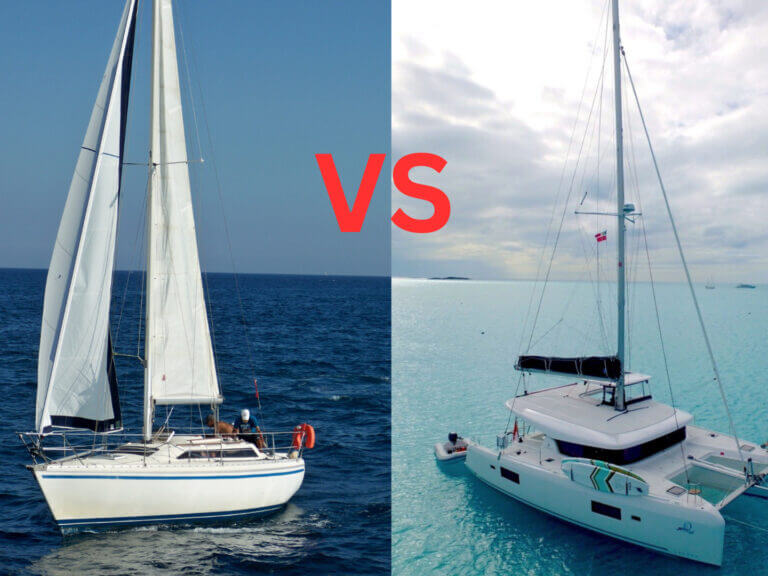
Monohulls vs. Catamarans: Which One is Best for You?
If you’re considering purchasing a sailboat, you might be wondering which type of vessel is best suited for your seafaring adventures. Fear not, for we’re here to help you weigh the differences between monohulls vs. catamarans to make an informed decision. Now, before we dive into the nitty-gritty details of hull design, sail handling, and…

How do Boats Float? Exploring the Science Behind Buoyancy
Sailboats float because the average density of the boat is less than the density of water. When boats displace as much water as it weights, this is known as the buoyancy force generated by Archimedes’ principle. If you’ve ever wondered how do boats float and therefor enable us to embark on thrilling water adventures, you’ve…

What is a Keel?: The Backbone of a Ship
As ships sail through tumultuous seas, their stability and maneuverability are tested to the fullest extent. The intricate design and engineering that go into a ship’s construction ensure that it can withstand the forces of nature and navigate through any challenging conditions. One of the most critical components of a ship’s design is the keel,…

Mainsail Furling Systems – Which one is right for you?
With the variety of options of mainsail furling systems available, including slab, in-boom, and in-mast systems, it can be challenging to determine which one best suits your needs. In this comprehensive guide, we will explore the pros and cons of each system, enabling you to make an informed decision that aligns with your sailing requirements….

How Does a Marine Toilet Work?
Have you ever wondered how a marine toilet works? If you’re planning to embark on a boating adventure or just curious about the mechanism of a marine toilet, this article is for you. Marine toilets work similarly to the ones on land with a bowl, a seat, and a flushing mechanism that uses water. However,…
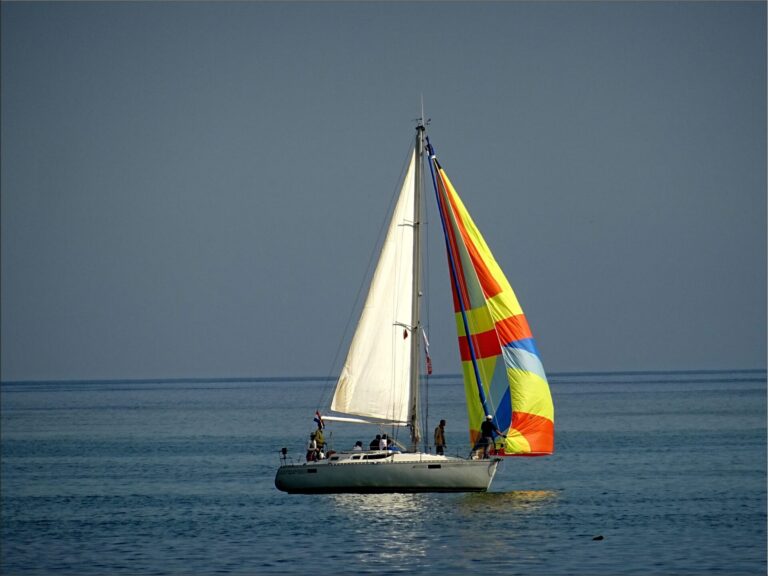
Types of Sails: A Comprehensive Guide
In the enchanting world of sailboat dynamics, where the dance between wind and water takes center stage, the significance of sails cannot be overstated. Like the wings of a bird, these meticulously crafted sails unfurl to catch the slightest whisper of breeze, converting it into a powerful forward thrust that carries us through the vast…
- Designating a Sober Operator: Ensuring Safety on Side Winder Boats
- The Ins and Outs of Boat Shipping: A Comprehensive Guide
- 3-Seater Jet Skis for Family Fun: The Ultimate Guide to Choosing the Perfect Personal Watercraft
- Cleaning and Detailing Side Winder Boats: The Ultimate Guide for Boat Owners
- Motorized boats
- Fishing boats
- Personal watercraft
- WaveRunners
- Cabin cruisers with sleeping quarters
- Bass boats with specialized fishing features
- Pontoon boats with built-in bars
- Cruising sailboats with comfort features
- Performance sailboats for racing
- Catamarans with spacious layouts
- High-speed WaveRunners for thrill-seekers
- 3-seater jet skis for family fun
- Sea-Doos with towing capabilities
- Luxury brands
- Azimut Yachts
- Ferretti Yachts
- Popular brands
- Boston Whaler
- Specialty brands
- Grady-White
- Bass Tracker
- MasterCraft
- Safety equipment
- Emergency signaling devices
- Life jackets
- Fire extinguishers
- Navigation tools
- Marine charts and maps
- GPS systems
- Comfort and convenience items
- Bimini tops
- Docking accessories
- New vs used boats
- Pros and cons of buying a new boat
- Benefits of purchasing a used boat
- Financing options
- Boat loans from banks or credit unions
- Manufacturer financing and promotions
- Boat insurance considerations
- Coverage options for different types of boats
- Factors that affect boat insurance rates
- Regular upkeep tasks
- Cleaning and detailing
- Oil changes and engine maintenance
- Battery care
- The Ins and Outs of Boat Shipping Costs
- Winterization procedures
- Storing the boat for the off-season
- Preventing freezing and damage
- Troubleshooting common issues
- Electrical issues and repairs
- Leaking hulls and patching
- Engine problems and solutions
- Boat handling techniques
- Navigating in rough waters
- Docking and launching tips
- Anchoring techniques
- Fishing tips and tricks
- Choosing the right bait and lures
- Reading fish finders and sonar
- Trolling strategies
- Maintenance and upkeep advice
- Cleaning and maintaining boat interiors
- Preventing corrosion and rust on metal parts
- Safe boating practices
- Designating a sober operator
- Checking weather conditions
- Wearing life jackets
- Boating regulations and laws
- Licensing and registration
- Required safety equipment on board
- Speed limits and no wake zones
- Emergency preparedness
- Stocking first aid supplies
- Knowing how to call for help
- Creating a float plan
- Types of boats
- All About Sloop: A Comprehensive Guide to Side Winder Boats
Everything You Need to Know About Sloop Boats for the Perfect Boating Experience

Welcome to our comprehensive guide to Sloop boats! If you're interested in sailboats, specifically the side winder variety, then you've come to the right place. In this article, we will dive into all things Sloop, from its history and design to its uses and benefits. Whether you're a seasoned sailor or just starting to explore the world of boats, this guide will provide you with valuable information and insights. So sit back, relax, and get ready to learn everything there is to know about Sloop boats from our trusted boat shipping company in our Silo on Types of Boats / Sailboats. First, let's start with the basics. A Sloop is a type of sailboat that has a single mast and a fore-and-aft rig.
It is one of the most popular sailboat designs and is known for its versatility and ease of use. Sloop boats come in various sizes and configurations, making them suitable for different types of water activities such as racing, cruising, and day sailing. One of the main features of a Sloop boat is its single mast, which makes it easier to handle compared to other sailboat designs with multiple masts. This also allows for a simpler rigging system, making it an ideal choice for beginners or those looking for a hassle-free sailing experience. There are various types of Sloop boats available, each with its own unique features and purposes. Some popular models include the Beneteau Oceanis, Catalina 22, and Hunter 33. These boats are designed for different types of water activities, from competitive racing to leisurely day sailing. When it comes to manufacturers, Beneteau, Catalina Yachts, and Hunter Marine are some of the top names in the industry.
These companies have been producing quality Sloop boats for decades and are known for their attention to detail and innovation in design. If you're in the market for a Sloop boat, there are a few things to consider before making a purchase. First, determine your budget and the type of activities you plan on doing with the boat. This will help narrow down your options and ensure that you get the best value for your money. It's also important to research and compare different models from various manufacturers to find the one that best fits your needs. Don't be afraid to ask questions and seek advice from experienced sailors or boat experts to make an informed decision. In addition to the boat itself, there are also various boating accessories that can enhance your sailing experience.
These include safety equipment, navigation tools, and convenience items such as coolers and storage solutions. Maintenance is also a crucial aspect of owning a Sloop boat. Regular cleaning and upkeep can prolong the life of your boat and ensure its safety and performance on the water. It's also important to follow manufacturer guidelines and schedule routine inspections and repairs as needed. Last but not least, it's essential to always prioritize safety when on a Sloop boat. This includes wearing proper safety gear, following boating regulations, and practicing good boating etiquette.
Fractional Rig
Types of sloop boats.
This allows for more efficient and faster sailing, making it popular for racing and performance sailing. The Masthead Rig, on the other hand, has a taller mast and smaller sail area, providing more stability and control in rougher waters. It is a popular choice for cruising and leisure sailing. Lastly, the Cat Rig only has one sail attached to the mast, making it easier to handle and maneuver.
It is great for beginners or single-handed sailing. When choosing a Sloop boat, consider your sailing style and needs to determine which type is best for you. Each type also has different manufacturers and models, so do your research to find the perfect fit. With this knowledge, you can confidently navigate the world of Sloop boats and choose the right one for your next sailing adventure.
Masthead Rig
The smaller jib sail also reduces the amount of heeling (when the boat leans to one side) and makes the boat easier to handle. This makes the Masthead Rig a popular choice for recreational boaters looking for a smooth and comfortable sailing experience. Some popular manufacturers of Sloop boats with Masthead Rigs include Beneteau, Hunter, and Catalina. These manufacturers offer various models with different features and designs to cater to the needs of different boaters.
When considering buying a Sloop boat with a Masthead Rig, it is important to do your research and understand the features and specifications of the boat. This will help you make an informed decision and ensure that you choose a boat that meets your specific needs and preferences. Additionally, investing in quality boating accessories and regularly maintaining your boat can help enhance your sailing experience and keep you safe on the water. In conclusion, the Masthead Rig is a popular choice for those in the market for a Sloop boat.
Its taller mast and smaller jib sail provide better performance in light winds, making it ideal for cruising. With the right knowledge and preparation, owning a Sloop boat with a Masthead Rig can provide endless opportunities for enjoyable sailing adventures. No matter what type of Sloop boat you choose, it is important to consider the features that best suit your needs. Look for boats with comfortable seating, ample storage space, and easy handling. When buying a used Sloop boat, make sure to thoroughly inspect it for any damages or maintenance issues.
Additionally, it is always a good idea to invest in boating accessories such as life jackets, first aid kits, and navigation tools for a safe and enjoyable boating experience.
Related Articles

- Trolling Strategies for Side Winder Boats: A Comprehensive Guide
Learn the best trolling strategies for Side Winder Boats and improve your boating experience. Discover tips on boat types, manufacturers, models, features, accessories, and maintenance.

- All You Need to Know About Cruisers: The Ultimate Guide to Side Winder Boats
Discover everything you need to know about Side Winder Boats, from types and models to maintenance and safety tips.

- A Comprehensive Guide to Checking Weather Conditions for Safe Boating Practices
In this article, we will cover everything you need to know about checking weather conditions for safe boating practices. From boat types and manufacturers to safety tips and boating accessories, we have got you covered.

- How to Choose the Perfect Cabin Cruiser with Sleeping Quarters for Your Boating Adventures
A Comprehensive Guide to Choosing and Maintaining the Ideal Side Winder Boat for Your Needs
- A Comprehensive Look at Fishing Boats for Boating Enthusiasts
- A Comprehensive Look at Pontoons: Everything You Need to Know
- The Ultimate Guide to Sunseeker: A Luxury Boat Manufacturer
- All About Sea-Doos: A Comprehensive Guide to Side Winder Boats
- All You Need to Know About Boston Whaler Boats
- All You Need to Know About Grady-White Boats
- Azimut Yachts: A Luxurious Brand in the World of Boating
- All You Need to Know About Catamarans
- A Complete Look at Ferretti Yachts: The Ultimate Luxury Boat Manufacturer
How to Choose the Perfect Bayliner Boat for You
- All About Jet Skis: A Comprehensive Guide
- A Comprehensive Guide to WaveRunners: Everything You Need to Know About Side Winder Boats
- A Comprehensive Look at Sea Ray Boats: Everything You Need to Know
- A Complete Overview of Bass Tracker Boats
- Bass Boats with Specialized Fishing Features: The Ultimate Guide to Choosing the Perfect Boat
- The Ultimate Guide to MasterCraft Boats
- How to Get the Most Out of Your Side Winder Boat
- How to Choose the Perfect Pontoon Boat with a Built-in Bar
Cruising Sailboats with Comfort Features: Enjoying the Best of Both Worlds
- Performance Sailboats for Racing: The Ultimate Guide
- Emergency Signaling Devices: Essential Accessories for Boating Safety
- The Pros and Cons of Buying a New Boat
- Catamarans: The Ultimate Guide to Spacious Layouts
- Boat Loans: Financing Options for Side Winder Boats
- A Comprehensive Guide to Marine Charts and Maps for Side Winder Boats
- Coverage Options for Different Types of Boats
- Factors That Affect Boat Insurance Rates
- Experience the Thrill of High-Speed WaveRunners
- A Comprehensive Guide to Understanding Compasses for Side Winder Boats
- The Importance of Life Jackets for Boating Safety
- A Comprehensive Look at Coolers for Boating Comfort and Convenience
- All You Need to Know About Bimini Tops
- Benefits of Purchasing a Used Boat: Everything You Need to Know
- The Ultimate Guide to Docking Accessories for Side Winder Boats
- Exploring the World of Sea-Doos with Towing Capabilities
- Fire Extinguishers: A Must-Have Boating Accessory for Safety on Side Winder Boats
- A Comprehensive Look at GPS Systems for Side Winder Boats
- Manufacturer Financing and Promotions for Side Winder Boats
- Navigating in Rough Waters: Tips for Side Winder Boats
- Storing Your Side Winder Boat for the Off-Season
- Oil Changes and Engine Maintenance: Keeping Your Side Winder Boat Running Smoothly
- A Comprehensive Look at Licensing and Registration for Side Winder Boats
Stocking First Aid Supplies for Side Winder Boats
- Electrical Issues and Repairs: A Comprehensive Guide for Side Winder Boat Owners
- Battery Care for Side Winder Boats
- Required Safety Equipment On Board: A Comprehensive Guide for Side Winder Boat Owners
- Wearing Life Jackets: A Must for Safe Boating on Side Winder Boats
- Understanding Speed Limits and No Wake Zones on Side Winder Boats
- Knowing How to Call for Help on a Side Winder Boat
- Docking and Launching Tips for Side Winder Boats
- Leaking Hulls and Patching: How to Maintain Your Side Winder Boat
- Engine Problems and Solutions for Side Winder Boats
- Preventing Freezing and Damage on Side Winder Boats
- Creating a Float Plan: A Comprehensive Guide for Side Winder Boat Owners
- Anchoring Techniques for Side Winder Boats
- Choosing the Right Bait and Lures for Side Winder Boats
- Cleaning and Maintaining Boat Interiors: Tips for Side Winder Boats
- Preventing Corrosion and Rust on Metal Parts: The Ultimate Guide for Side Winder Boat Owners
- Reading Fish Finders and Sonar: A Comprehensive Guide for Side Winder Boat Owners
Recent Posts

Which cookies do you want to accept?

Sailboat Sloop: The Ultimate How To
Introduction:.
The sailboat sloop is a popular type of watercraft designed to cater to the needs of sailing enthusiasts and adventurers seeking thrilling journeys on the open water. These boats offer a balanced combination of performance, ease of handling, and comfortable accommodations. In this comprehensive comparison, we will delve into the key characteristics of sailboat sloops, including their design, features, rigging options, and discuss the top brands in the market.
Sailboat Sloop Design and Purpose:
Sailboat sloops are meticulously designed to provide a versatile sailing experience. They typically feature a single mast and a sloop rig configuration consisting of a mainsail and a headsail, such as a genoa or jib. The hull design of sailboat sloops prioritizes stability, speed, and maneuverability, allowing sailors to navigate various sailing conditions with confidence. With their moderate displacement and keel or centerboard, sailboat sloops excel in coastal cruising as well as longer voyages.
Sailboat Sloop Key Features:
Sailboat sloops have comfortable accommodations for extended stays on the water. It includes spacious cabins, a well-equipped galley, and a salon area for dining and relaxation. The interiors are designed to maximize living space and provide essential amenities for a comfortable sailing experience.
- Efficient Sail Handling Systems: Sailboat sloops feature efficient sail-handling systems that make it easy to adjust sails for optimal performance. These systems often include roller furling headsails and in-mast or in-boom furling mainsails, allowing sailors to quickly and effortlessly adapt to changing wind conditions. The incorporation of winches and control lines further enhances the ease of sail handling.
- Stability and Performance: Sailboat sloops prioritize stability and performance to deliver an exhilarating sailing experience. Their hull designs and keel configurations provide stability and reduce excessive rolling in rough seas. Sailboat sloops are known for their balanced performance, combining speed and maneuverability without compromising on comfort, allowing sailors to enjoy both leisurely cruising and spirited sailing.
The Sloop Rig:
The sloop rig consists of a single mast and two sails—a mainsail and a headsail (genoa or jib). This rig allows for easy handling and adaptability in various wind conditions, making it suitable for a wide range of sailing styles, from leisurely coastal cruising to more challenging offshore passages.
Appropriate Buyers and Considerations:
Sailboat sloops are ideal for sailing enthusiasts who appreciate a balanced combination of performance and comfort. When considering a sailboat sloop, potential buyers should take the following factors into account:
- Sailing Preferences: Determine your preferred style of sailing, whether it’s coastal cruising, day sailing, or longer voyages. This will help you choose a sailboat sloop that aligns with your intended use and sailing goals.
- Accommodation Needs: Consider the number of people you plan to accommodate on board and ensure the boat provides sufficient sleeping quarters and living space. Evaluate the functional galley, marine head, and storage capacity.
- Budget: Sailboat sloops vary in price depending on factors such as size, brand, features, and rigging options. Establishing a budget and researching different models within your price range will help you find the best sailboat sloop.
Sailboat Sloop Top Brands:
When searching for a sailboat sloop, it’s essential to explore reputable brands known for their quality construction, sailing performance, and cruising-specific features. Here are three top sailboat sloop brands worth considering:
- Beneteau is a renowned sailboat sloop brand that has earned a stellar reputation for its extensive range of sailboats designed for cruising and racing. Known for their exceptional performance, innovative design, and superior craftsmanship, Beneteau sailboats are favored by sailors worldwide.
- Beneteau sailboats are meticulously engineered to deliver optimal sailing performance. Their sloop designs incorporate advanced hull shapes, efficient sail plans, and cutting-edge rigging systems, allowing for excellent speed and maneuverability on the water. Whether you’re navigating coastal waters or embarking on offshore adventures, Beneteau sailboats offer a perfect balance of performance and comfort.
- The interiors of Beneteau sailboats are carefully designed to maximize space and functionality. With a focus on ergonomic layouts and high-quality materials, these sailboats provide comfortable accommodations for extended stays. Beneteau offers a variety of cabin configurations, ensuring that sailors have ample room for sleeping, dining, and relaxing onboard.
- Beneteau sailboats cater to a diverse range of sailing preferences and needs. From compact cruisers to luxurious yachts, the brand offers models suited for different cruising styles and requirements. Whether you’re a seasoned sailor or a novice looking to embark on your first sailing adventure, Beneteau sailboats provide the performance, comfort, and versatility to meet your expectations.

- Jeanneau is a prestigious sailboat sloop brand that has become synonymous with elegance, performance, and cruising comfort. With a strong emphasis on innovative design, quality construction, and attention to detail, Jeanneau sailboats are highly regarded by sailing enthusiasts around the globe.
- Jeanneau sailboats are designed to deliver exceptional sailing performance. Their sloop configurations feature sleek hulls, efficient sail plans, and advanced rigging systems, enabling sailors to enjoy exhilarating experiences on the water. These sailboats are known for their stability, responsiveness, and ease of handling, making them ideal for both short trips and long-distance cruising.
- The interiors of Jeanneau sailboats exude sophistication and comfort. Crafted with meticulous care, the cabins offer spacious living areas, ergonomic layouts, and high-quality finishes. Jeanneau prioritizes creating inviting and functional spaces, ensuring that sailors have a cozy retreat to relax and unwind after a day of sailing.
- Jeanneau sailboats encompass a wide range of models, accommodating different sailing preferences and needs. From compact cruisers to luxurious yachts, the brand offers options for sailors of all levels of experience. With their focus on performance, comfort, and stylish design, Jeanneau sailboats continue to impress and inspire sailors worldwide.

Hylas Yachts:
- Hylas Yachts is a renowned sailboat sloop brand known for its exceptional craftsmanship, luxurious interiors, and outstanding sailing performance. They are meticulously built with attention to detail, incorporating high-quality materials and innovative design elements.
- Sailors appreciate Hylas Yachts for their seaworthiness and excellent performance under sail. These sailboat sloops feature advanced rigging systems, efficient sail handling, and well-balanced hull designs. Hylas Yachts are designed to offer a perfect balance of speed, stability, and comfort, making them a preferred choice for long-distance cruising and offshore passages.
- The interiors of Hylas Yachts are crafted with elegance and functionality in mind. The cabins are spacious, featuring luxurious accommodations and ample storage space. Hylas Yachts are known for their attention to detail in the craftsmanship of their interiors, providing a comfortable and inviting environment for extended stays on board.
- Hylas Yachts offer a range of models to cater to different sailing preferences and requirements. Whether you’re seeking a compact sloop for coastal cruising or a larger yacht for extended offshore adventures, Hylas Yachts provides options to suit various needs. Their commitment to quality, performance, and luxury has solidified Hylas Yachts as one of the top brands in the market.
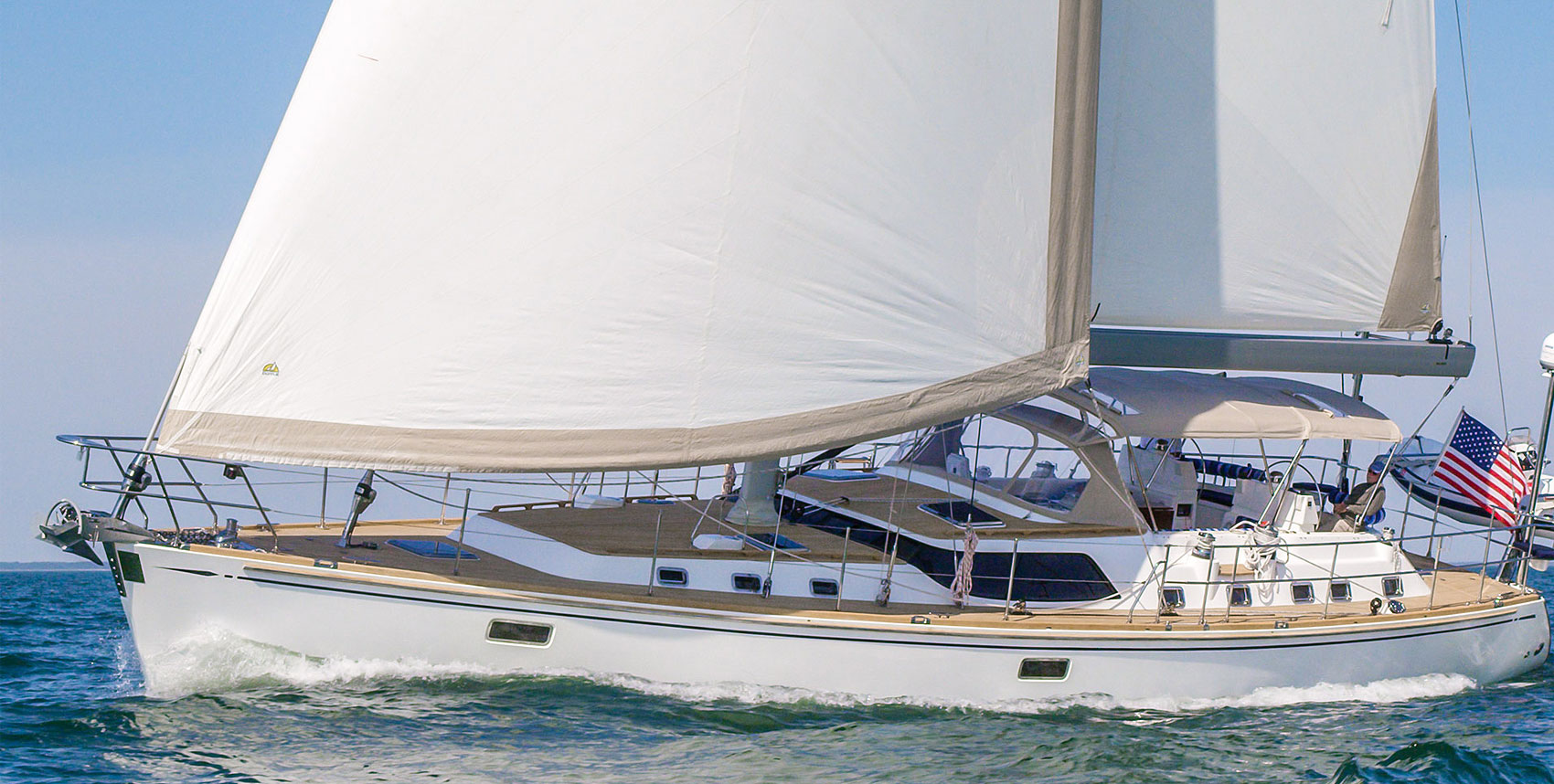
Conclusion:
Sailboat sloops provide sailing enthusiasts with a versatile and thrilling experience, combining performance, ease of handling, and comfortable accommodations. When considering a sailboat sloop, it’s important to evaluate the design, key features, rigging options, and accommodation needs to find a boat that suits your specific sailing requirements. Exploring reputable brands such as Beneteau, Jeanneau, and Hanse will assist you in making an informed decision and selecting a sailboat sloop that delivers both performance and comfort on the water.
We encourage you to use Rabbet to connect with the rest of the boating community! Hop onto our Learn tab to find more articles like this. Join our various forums to discuss with boating enthusiasts like you. Create an account to get started.
Visit us on Pinterest to collect content and inspire others.
Previous Post Wooden Boats: The Ultimate Poetry
Next post boat hull materials: everything you need to know, related posts.
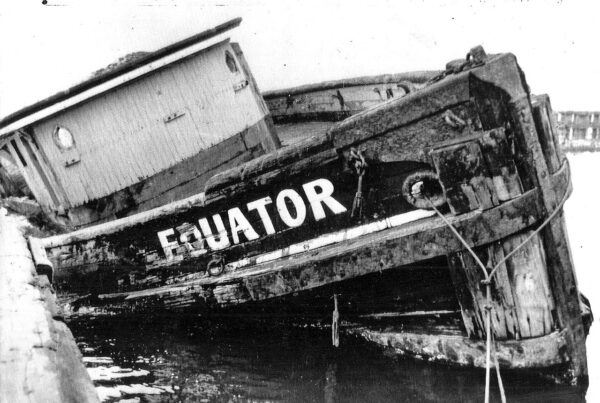
Downsizing and Living Aboard for Retirees and Empty Nesters

Sloop Rigged Sailboat: The Ultimate Guide
by Emma Sullivan | Aug 18, 2023 | Sailboat Maintenance

Short answer: Sloop rigged sailboat
A sloop rigged sailboat is a type of sailboat that features a single mast and two sails, namely a mainsail and a headsail. This popular rigging configuration allows for efficient sailing both upwind and downwind, making it widely used in recreational and racing boats. The sloop rig provides versatility and ease of handling, contributing to its popularity among sailors worldwide.
The Basics of a Sloop Rigged Sailboat: A Comprehensive Guide
Welcome aboard, sailing enthusiasts ! If you’re new to the world of sailboats or simply looking to expand your knowledge, you’ve come to the right place. In this comprehensive guide, we’ll delve into the intricacies of a sloop rigged sailboat – an iconic and versatile vessel that has captured the hearts and minds of sailors worldwide.
So, grab your nautical charts, put on your captain’s hat, and get ready to set sail on a journey through the basics of a sloop rigged sailboat.
1) What is a Sloop Rigged Sailboat? A sloop rigged sailboat refers to a popular type of sailing vessel with one mast and two sails – a mainsail located at the rear (aft) of the mast and a headsail at the front (forward). This configuration allows for efficient wind capture and provides great maneuverability in different wind conditions.
2) The Main Components: a) Mainsail: The mighty mainsail is typically the largest sail on the boat. Its purpose is to harness wind power and propel the vessel forward. Positioned behind the mast, it generates most of the driving force required for sailing.
b) Headsail: Also known as a jib or genoa, this smaller sail is located at the front part of the boat . It assists in catching additional wind and adds balance by counteracting some forces exerted by the mainsail. Headsails come in various sizes depending on wind conditions.
3) Benefits of a Sloop Rigged Sailboat: Why choose a sloop rig? Well, here are some compelling reasons:
a) Versatility: A sloop rig offers versatility across various wind conditions – from light breezes to stronger gusts. By adjusting or changing headsails, sailors can optimize their vessel’s performance without compromising control.
b) Maneuverability: Due to the simplicity of controlling two sails, a sloop rigged sailboat is more maneuverable compared to other sail setups. This means easier tacking (changing direction against the wind) and gybing (changing direction with the wind).
c) Efficiency: The streamlined design of a sloop rig maximizes efficiency by reducing drag and sail interference. It allows for better pointing ability (sailing closer into the wind) and improved upwind performance.
4) Additional Sailing Terms: To truly navigate the jargon-laden seas, it’s essential to familiarize yourself with key sailing terms related to sloop rigged sailboats. Here are a few important ones:
a) Halyards: Ropes used to raise or lower sails. The mainsail halyard raises the mainsail while the headsail halyard controls the headsail’s position.
b) Sheets: Lines used to control sail trim – one for the mainsail and another for the headsail. By adjusting these sheets, sailors can optimize their sail shape in different wind conditions.
c) Tacking and Gybing: As mentioned earlier, tacking involves turning a boat into the wind to change its direction, while gybing is turning away from the wind.
d) Reefing: The process of reducing a sail’s area by partially lowering it or rolling it up, often necessary in strong winds to maintain control.
5) Conclusion: Congratulations on completing this comprehensive guide ! By now, you understand what makes a sloop rigged sailboat such an appealing choice for sailors worldwide. From its versatility and maneuverability to enhancing efficiency in various wind conditions, this configuration is beloved by both seasoned mariners and newcomers alike.
So next time you set foot on a sloop rigged sailboat, confidently command your vessel using your newfound knowledge. Remember that sailing is not just about skill but also an art form that embraces nature’s elements; embrace them wholeheartedly as you embark on thrilling adventures across the open water.
Happy sailing!
How to Rig a Sloop Sailboat: Step-by-Step Instructions for Beginners
Title: Mastering the Art of Rigging a Sloop Sailboat: Comprehensive Step-by-Step Guide for Aspiring Seafarers
Introduction:
Embarking on a sailing adventure is an exhilarating experience, and rigging a sloop sailboat lays the foundation for an unforgettable voyage on the open waters. If you’re a beginner eager to unravel the secrets of this ancient art, we’ve got your back! In this guide, we’ll walk you through the step-by-step process of rigging a sloop sailboat like a seasoned sailor. So, hoist your sails, batten down the hatches, and let’s dive right in!
Section 1: Understanding the Basics
Before diving into the rigging process, it’s essential to grasp some fundamental concepts. A sloop sailboat typically consists of two sails—a mainsail and a headsail—hinged around one mast.
Section 2: Gathering Your Tools
To ensure smooth sailing during the rigging process, assemble these vital tools:
1. Sailors’ Bag: – Multitool with pliers, knife, and wrench attachments. – Marlin spike for untying knots. – Shackles and carabiners for attaching lines.
2. Safety Equipment: – Life jacket or personal flotation device (PFD). – High-quality sailing gloves.
3. Essential Lines: – Halyards to raise and lower sails. – Sheets that control sails’ trim .
Section 3: The Step-by-Step Process
Step 1: Prepare Your Boat Ensure your boat is docked securely before starting any rigging work. It’s crucial to maintain stability throughout the process by fixing your boat firmly using anchors or dock lines.
Step 2: Hoisting the Main Sail Attach each halyard—one from each side—to designated points on either side of the main sail near its head. Make sure the halyards run smoothly through blocks and do not twist or tangle. Raise the main sail steadily using a winch until it reaches its full height.
Step 3: Handling the Sheets Connect one end of each sheet—one from each side—to their respective clew points on the main sail . Ensure proper alignment without crossing lines. Lead both sheets aft through the boom, adjusting tension for optimal sail trim.
Step 4: Setting Up the Headsail Begin by attaching the halyard to a designated point near the head of your headsail, ensuring smooth running through blocks. Hoist it with moderate tension until it unfurls but remains manageable in low winds.
Step 5: Positioning Jib Sheets Securely connect each jib sheet—one from each side—to their appropriate clew points on your headsail, allowing free movement when adjusting trim. Remember to lead them back to a location where you can efficiently control and adjust their tension.
Section 4: Safety Precautions and Additional Tips
1. Always Wear a Life Jacket: Prioritize safety at all times by wearing a properly-fitted life jacket or PFD while rigging and sailing .
2. Familiarize Yourself with Nautical Knots: Understanding essential knots like reef knots, bowlines, and clove hitches will greatly aid you in securing lines during rigging processes.
3. Don’t Rush: Take your time during every step of rigging to avoid mistakes that could lead to accidents or improper sail function .
Conclusion:
As sailing enthusiasts ourselves, we understand how tempting it is to skip past crucial steps while rigging a sloop sailboat; however, mastering this process paves the way for blissful seafaring adventures in style. By following this comprehensive guide designed specifically for beginners, you’ll be well-equipped with both knowledge and practical skills needed to rig your sloop sailboat with finesse. So, grab your sailors’ bag, breathe in the salty air, and embark on your exciting sailing journey like a seasoned mariner!
Frequently Asked Questions About Sloop Rigged Sailboats, Answered!
Are you considering purchasing a sloop rigged sailboat? Do you have questions about its design, functionality, or performance on the water? Look no further! In this blog post, we will delve into some of the frequently asked questions about sloop rigged sailboats and provide you with insightful answers to aid in your decision-making process. So, let’s set sail on this nautical adventure and get those queries answered!
1. What is a sloop rig?
A sloop rig refers to a sailing boat that has one mast and two sails – a mainsail and a headsail (commonly known as a jib or genoa). The main characteristic of this configuration is versatility. With both sails working together, the boat can efficiently harness wind power across various wind conditions.
2. Why are sloop rigs so popular?
Sloop rigs have gained immense popularity among sailors due to their flexibility and ease of handling. The ability to balance the mainsail and headsail allows for fine-tuning depending on wind strength and direction. This adaptability makes sloop rigs suitable for diverse sailing adventures, from racing in challenging regattas to leisurely cruising with family and friends.
3. How do I know which size headsail is right for my sloop rig?
The choice of headsail size depends on several factors such as boat size, anticipated wind conditions, and personal preference. As a general rule of thumb, larger boats tend to use genoas with larger overlapping areas, providing more driving force in lighter winds. On the other hand, smaller boats might benefit from self-tacking jibs that require less crew effort during maneuvers.
4. What are the advantages of having a single mast?
Having only one mast simplifies the overall design and maintenance of a sailboat while reducing costs associated with rigging hardware and maintenance tasks like checking multiple spreaders or stays. Additionally, it makes maneuvering under bridges or low clearance areas less complicated, ensuring that your sailing adventures are not confined solely to open waters .
5. Can I sail a sloop rig alone?
Yes, you can! Sloop rigged sailboats are renowned for their excellent single-handed capabilities. The balanced configuration of the sails allows for relatively easy trimming and handling, making it possible for a competent sailor to operate the boat without assistance. However, caution should always be exercised while sailing solo, especially in challenging weather conditions .
6. Are there any drawbacks to choosing a sloop rig?
While sloop rigs are versatile and beloved by many sailors, they do have some limitations. When encountering heavy weather or strong winds, sail changes may be required more frequently compared to other configurations like ketch or cutter rigs. Additionally, managing the headsail when sailing upwind can pose challenges due to its larger area relative to the mainsail.
In conclusion, sloop rigged sailboats offer a sought-after combination of versatility and ease of handling that has propelled them into popularity among sailors worldwide. The ability to adapt to various wind conditions and their single-handed capabilities make them appealing choices for both seasoned sailors and novices setting out on their nautical journeys. However, it’s crucial to consider the specific requirements of your sailing plans before committing to this rig configuration.
So set your sights on those open waters and hoist those sails high; with a sloop rigged sailboat beneath you, there is little stopping you from embarking on unforgettable sailing adventures!
Exploring the Advantages of a Sloop Rigging Design in Sailboats
Title: Unraveling the Hidden Gems: Exploring the Advantages of a Sloop Rigging Design in Sailboats
Introduction: When it comes to sailboat rigging designs, one design stands out among the rest – the sloop rigging. This elegant and versatile configuration has been favored by sailors for centuries. In this blog post, we embark on a captivating journey to unravel the numerous advantages of choosing a sloop rigging for your sailboat . Brace yourself as we navigate through its professional, witty, and clever intricacies!
1. Versatility at Its Finest: The sloop rigging design encapsulates versatility like no other. With its single mast and two sails – a mainsail and a headsail – sailboats equipped with sloop rigs can adapt effortlessly to varying weather conditions. Be it gentle zephyrs or gale-force winds; the adaptability of a sloop allows sailors to cruise comfortably across all conditions.
2. Superior Upwind Performance: While many rigs struggle against headwinds, the sloop rig shines bright as an epitome of upwind performance mastery. Thanks to its efficient aerodynamics, the powerful mainsail delivers excellent propulsion by capturing and funneling favorable air currents into forward momentum. Meanwhile, the smaller headsail optimizes balance while maintaining manageable helm control.
3. Ease of Handling: Sailing should be an enjoyable experience that doesn’t require constant battling with complicated rig configurations. The beauty of a sloop rig lies in its simplicity. The ability to hoist or reef sails quickly turns novice sailors into confident captains navigating effortlessly through unpredictable waters .
4. Enhanced Maneuverability: Picture this: you encounter an unexpected obstacle on your sailing adventure—a tight angle that demands nimble navigation skills and quick reaction times from your sailboat’s rigging setup! Fear not, for with a perfectly balanced sloop rig design, executing even challenging maneuvers becomes an exhilarating experience. Sailors can effortlessly tack, jibe, and alter their course without compromising stability or control.
5. Reduced Crew Requirements: When you embark on a solo sailing voyage, having a sailboat that complements self-reliance is essential. The sloop rig offers exactly this advantage by minimizing crew requirements. With the right combination of high-quality winches, cleats, and easily adjustable lines, managing the sails becomes a one-person job. Feel like taking your sailing escapade to new horizons? The sloop rig provides the freedom to do so independently!
6. Enhanced Performance in Light Winds: Navigating through calmer waters brings its own charm but often poses challenges for other rigging configurations . Enter the sloop rig’s lighter headsail! This smaller sail allows sailors to harness even the slightest breeze efficiently while enjoying serene moments at sea.
7. Wide Range of Combinations: From schooners to cutters, ketches to yawls – sloop rigs have served as an inspiration for various hybrid designs throughout history. Sailboat enthusiasts find immense pleasure in exploring different combinations within a sloop rig setup, tailoring their craft to match their unique preferences and sailing goals.
Conclusion: As sailors prepare to embark on exhilarating adventures across vast oceans or tranquil lakes alike, it becomes paramount to choose a sailboat equipped with the right rigging design – one that truly encapsulates versatility, maneuverability, ease of handling, and enhanced performance under diverse conditions. The timeless beauty of a sloop rigging design offers all these advantages and more! So set sail with confidence; may your journey be filled with professional expertise intertwined with wittiness and cleverness – all brought to life through your trusty sloop-rigged vessel!
Mastering the Art of Sailing: Tips and Tricks for Maneuvering a Sloop Rigged Sailboat
Sailing is not just a hobby; it is an art form that requires skill, finesse, and a deep understanding of the elements. For those who have chosen to embark on this exhilarating adventure, mastering the art of sailing is a lifelong pursuit. In this blog post, we will delve into the world of sloop rigged sailboats and provide you with some valuable tips and tricks to enhance your maneuvering abilities.
First things first – what exactly is a sloop rigged sailboat? A sloop rig consists of a single mast located towards the front of the boat , along with two sails – a mainsail attached to the mast and a foresail or jib at the front. This configuration offers simplicity in terms of handling and maneuverability, making it ideal for beginners as well as seasoned sailors .
To truly master the art of sailing in a sloop rigged sailboat, one must develop expert handling techniques. One important aspect to consider is trimming your sails correctly. The main sail controls your boat ‘s speed and direction while sailing upwind, whereas the jib helps with balance and stability. By adjusting these sails appropriately based on wind conditions, you can optimize your boat ‘s performance.
When tacking or turning through the wind in order to change direction, pay close attention to steering techniques. To execute successful tacks smoothly and efficiently, always plan ahead by assessing wind direction and anticipating any obstacles or other boats nearby. Maintain control of your helm throughout the tack by making small adjustments rather than abrupt maneuvers .
Another fundamental skill in sailing is knowing how to gybe – turning downwind while crossing through the wind. When gybing in a sloop rig setup, always be cautious as this maneuver can be quite powerful due to changes in wind pressure against both sails simultaneously. It is essential to properly control your mainsail during this maneuver by keeping tension on its sheets while giving careful attention to maintaining balance.
Successfully docking or mooring a sailboat is an additional critical aspect to master. The ability to approach a dock or mooring buoy confidently and skillfully will greatly enhance your sailing experience. To ensure a smooth docking, it is crucial to consider wind direction, current, and space limitations in relation to your boat’s maneuverability. Practice various docking techniques such as the ‘bow-in’ or ‘stern-in’ method to increase your versatility.
Now that we have covered some of the key techniques for maneuvering a sloop rigged sailboat, let’s discuss some tips and tricks to make your sailing experience even more enjoyable.
1. Stay aware of your surroundings: Always be mindful of other boats, navigational hazards, and changing weather conditions . Keep in touch with VHF radios or marine apps on smartphones for any necessary communication.
2. Practice makes perfect: Spend time on the water honing your skills by undertaking various maneuvers repeatedly. With practice comes confidence and fine-tuned abilities.
3. Communicate effectively with crew members: Clear communication is essential when working together to maneuver the sailboat smoothly . Develop efficient communication protocols that everyone can understand and follow.
4. Seek advice from experienced sailors: Attend sailing seminars, join sailing clubs, or connect with seasoned sailors who can offer invaluable insights based on their own experiences.
5. Embrace challenges: Sailing can be unpredictable at times; don’t shy away from challenging conditions or maneuvers. Instead, view them as opportunities for growth and improvement.
In conclusion, mastering the art of sailing a sloop rigged sailboat demands constant learning, practice, and attention to detail. By focusing on proper sail trimming techniques along with proficient steering methods like tacking and gybing, you can navigate through diverse wind conditions effortlessly. Additionally, mastering docking maneuvers while maintaining awareness of your surroundings will ensure safe adventures on the open water.
So hoist those sails high, keep an eye on the horizon ahead and embark upon this incredible journey of mastering the art of sailing a sloop rigged sailboat. Happy sailing!
Advancing Your Skills: Expert Advice on Upgrading and Maintaining a Sloop Rigged Sailboat
Welcome aboard, sailors! Today, we are thrilled to present you with expert advice on advancing your skills in upgrading and maintaining a sloop rigged sailboat. Whether you are an experienced sailor looking to take your sailing game to the next level or a novice just beginning your nautical journey, this blog post is for you.
The sloop rig is one of the most popular and versatile sailboat configurations out there. Consisting of a single mast and two sails, the main and jib, it offers simplicity and efficiency while providing enough power to tackle various weather conditions . However, like any vessel, a sloop rigged sailboat requires regular care and potential upgrades to keep it sailing smoothly.
1. Regular maintenance: The key to prolonging the life of your boat lies in its regular maintenance . From checking for any signs of wear and tear on your rigging to inspecting hull integrity and cleaning the bottom of your boat, consistency is crucial. By establishing a routine maintenance schedule that encompasses these tasks along with others like lubricating winches, checking light fixtures, and servicing the engine if applicable, you can ensure that your sloop rig remains in tip-top shape throughout its lifetime.
2. Upgrading your rig: As technology advances in the sailing world, it’s essential to stay updated with modern equipment that can enhance both performance and safety on board. If you’re considering upgrading certain aspects of your sloop rig setup, there are several areas worth exploring:
– Sails: Investing in high-quality sails specifically designed for optimal performance in different wind conditions can make a world of difference. Consider lightweight materials that increase speed or durable options for more rugged sailing environments.
– Rigging: Keeping up with advancements in rigging technology can greatly benefit your sailing experience. Upgrade options like low-stretch lines or high-performance blocks can improve maneuverability while reducing overall wear on your boat.
– Electronics: Equipping your sailboat with modern navigational and communication systems can enhance safety and convenience. From GPS chartplotters to AIS (Automatic Identification System) receivers, these upgrades provide valuable information on your vessel’s position and the surrounding maritime traffic.
3. Developing your sailing skills: An upgraded sailboat is only as good as the sailor operating it. In addition to investing in your boat, advancing your own sailing skills is paramount. Attend local sailing courses or workshops offered by experienced sailors or sailing clubs, allowing you to learn new techniques, strategies, and safety protocols specific to sloop rigged sailboats.
4. Joining a community: Engaging with fellow sailors who share your passion for sloop rigged sailboats is a valuable way to boost your knowledge and broaden your horizons. Participating in regattas, joining online forums like Sailnet or CruisersForum, or even connecting with local yacht clubs can expose you to a wealth of wisdom and provide opportunities for networking and collaboration.
Remember, upgrading and maintaining a sloop rig sailboat isn’t just about improving performance; it’s about ensuring the safety of yourself, your crew, and the vessel itself. By incorporating regular maintenance practices, exploring upgrade options that suit your needs, actively honing your sailing skills, and engaging with the vibrant sailing community around you, you will set yourself up for an extraordinary voyage filled with thrilling adventures on the high seas.
So grab that rigging manual, hoist those sails high, and set forth on an incredible journey of advancing your skills in upgrading and maintaining a sloop rigged sailboat!
Recent Posts

- Sailboat Gear and Equipment
- Sailboat Lifestyle
- Sailboat Maintenance
- Sailboat Racing
- Sailboat Tips and Tricks
- Sailboat Types
- Sailing Adventures
- Sailing Destinations
- Sailing Safety
- Sailing Techniques
17 Sailboat Types Explained: How To Recognize Them
Ever wondered what type of sailboat you're looking at? Identifying sailboats isn't hard, you just have to know what to look for. In this article, I'll help you.
Every time I'm around a large number of sailboats, I look around in awe (especially with the bigger ones). I recognize some, but with most of them, I'll have to ask the owner. When they answer, I try to hide my ignorance. The words don't make any sense!
So here's a complete list with pictures of the most common sailboat types today. For each of them, I'll explain exactly where the name comes from, and how you can recognize it easily.

So here's my list of popular sailboat types, explained:
Bermuda sloop, sailing hydrofoil, dutch barge, chinese junk, square-rigged tall ship, in conclusion, how to recognize any sailboat.
Before we get started, I wanted to quickly explain what you should look for when you try to identify a sailboat.
The type of sailboat is always determined by one of these four things:
- The type of hull
- The type of keel
- The number of masts
- And the type of sails and rig
The hull is the boat's body. There are basically three hull types: monohull, catamaran, and trimaran. Simply said: do I see one hull, two hulls (catamaran) or three hulls (trimaran)? Most sailboats are monohulls.
Next, there is the keel type. The keel is the underwater part of the hull. Mostly, you won't be able to see that, because it's underwater. So we'll leave that for now.
The sail plan
The last factor is the number of masts and the sail plan. The sail plan, simply put, is the number of sails, the type of sails, and how the sails are mounted to the masts (also called rigging ).
Sailboat are mostly named after the sail plan, but occasionally, a sail type is thrown in there as well.
So now we know what to pay attention to, let's go and check out some sailboats!

Dinghies are the smallest and most simple sailboats around.
They are your typical training sailboats. Small boats with an open hull, with just one mast and one sail. Perfect for learning the ways of the wind.
On average, they are between 6 and 20 ft long. Mostly sailed single-handed (solo). There's no special rigging, just the mainsail. The mainsail is commonly a Bermuda (triangular) mainsail. Dinghies have a simple rudder stick and no special equipment or rigging.
Dinghies are great for learning how to sail. The smaller the boat, the better you feel the impact of your trim and actions.
How to recognize a sailing dinghy:
- short (8ft)
- one Bermuda sail
- open hull design
- rudder stick
Common places to spot them: lakes, near docks

If you'd ask a kid to draw a sailboat, she'll most probably draw this one. The Bermuda Sloop is the most popular and most common sailboat type today. You'll definitely recognize this one.
How to recognize a Bermuda Sloop:
- triangular mainsail (called a Bermuda sail)
- a foresail (also called the jib)
- fore-and-aft rigged
- medium-sized (12 - 50 ft)
Fore-and-aft rigged just means "from front to back". This type of rigging helps to sail upwind.
Any sailboat with one mast and two sails could still be a sloop. Even if the sails are another shape or rigged in another way. For example, here's a gaff-rigged sloop (more on the gaff rig later):

If you want to learn all about sail rigs, check out my full Guide to Understanding Sail Rig Types here. It has good infographics and explains it in more detail
The Bermuda sloop has a lot of advantages over other sailboat types (which is why it's so popular):
- the Bermuda rig is very maneuverable and pretty fast in almost all conditions
- it's really versatile
- you can sail it by yourself without any problems
- it's a simple setup
Common places to spot a sloop: everywhere. Smaller sloops are more common for inland waters, rivers, and lakes. Medium-sized and large sloops are very popular cruising boats.

Cutters have one mast but three or more sails. Most cutters are Bermuda rigged, which means they look a lot like sloops.
How to recognize a cutter:
- looks like a sloop
- two or more headsails instead of one
- commonly one mast
- sometimes an extra mast with mainsail
Cutters have more sail area, which makes them faster, but also harder to sail single-handed. There's also more strain on the mast and rigging.
Common places to spot a cutter: everywhere. Cutters are very popular for cruising.
They mostly have a Bermuda rig, which means triangular sails. But there are also gaff cutters and naval cutters, and some have two masts.
Here's an example of a two-masted naval cutter with an extra gaff mainsail and top gaff:

The Hydrofoil is a pretty new sailboat design. It's a racing sailboat with thin wing foils under the hull. These lift up the hull, out of the water, reducing the displacement to nearly zero. The foils create downforce and keep it from lifting off entirely.
This makes the hydrofoil extremely fast and also impressive.
The hydrofoil refers to the keel type. There are both monohull and multihull hydrofoils.
How to recognize a hydrofoil:
- it flies above the waterline and has small fins
Common places to spot a hydrofoil: at racing events

Famous catamaran: La Vagabonde from Sailing La Vagabonde
A catamaran is a type of cruising and racing multihull sailboat with two hulls. The hulls are always the same size.
Most catamarans have a standard Bermuda rig. The catamaran refers to the hull, so it can have any number of masts, sails, sail types and rig type.
How to recognize a catamaran:
- any boat with two hulls is called a catamaran
Common places to spot catamarans: coastal waters, The Caribbean, shallow reefs
The advantages of a catamaran: Catamarans heel less than monohulls and are more buoyant. Because of the double hull, they don't need as deep a keel to be stable. They have a smaller displacement, making them faster. They also have a very shallow draft. That's why catamarans are so popular in the Caribbean, where there's lots of shallow water.
Catamarans are nearly impossible to capsize:
"Compared with a monohull, a cruising catamaran sailboat has a high initial resistance to heeling and capsize—a fifty-footer requires four times the force to initiate a capsize than an equivalent monohull." Source: Wikipedia

How to recognize a trimaran:
- any boat with three hulls is called a trimaran
Trimarans have three hulls, so it's a multi-hull design. It's mostly a regular monohull with two smaller hulls or floaters on the sides. Some trimarans can be trailered by winching in the auxiliary hulls, like this:

This makes them very suitable for long-term cruising, but also for regular docking. This is great for crowded areas and small berths, like in the Mediterranean. It sure is more cost-effective than the catamaran (but you also don't have the extra storage and living space!).
Common places to spot Trimarans: mostly popular for long-term cruising, you'll find the trimaran in coastal areas.

Gaffer refers to gaff-rigged, which is the way the sails are rigged. A gaff rig is a rectangular sail with a top pole, or 'spar', which attaches it to the mast. This pole is called the 'gaff'. To hoist the mainsail, you hoist this top spar with a separate halyard. Most gaffers carry additional gaff topsails as well.
Gaff rigs are a bit less versatile than sloops. Because of the gaff, they can have a larger sail area. So they will perform better with downwind points of sail. Upwind, however, they handle less well.
How to recognize a gaffer:
- sail is rectangular
- mainsail has a top pole (or spar)
Since a gaffer refers to the rig type, and not the mast configuration or keel type, all sailboats with this kind of rigging can be called 'gaffers'.
Common places to spot a gaffer: Gaffers are popular inland sailboats. It's a more traditional rig, being used recreationally.

Schooners used to be extremely popular before sloops took over. Schooners are easy to sail but slower than sloops. They handle better than sloops in all comfortable (cruising) points of sail, except for upwind.
How to recognize a schooner:
- mostly two masts
- smaller mast in front
- taller mast in the back
- fore-and-aft rigged sails
- gaff-rigged mainsails (spar on top of the sail)
Common places to spot a schooner: coastal marinas, bays

How to recognize a ketch:
- medium-sized (30 ft and up)
- smaller mast in back
- taller mast in front
- both masts have a mainsail
The ketch refers to the sail plan (mast configuration and type of rig). Ketches actually handle really well. The back mast (mizzenmast) powers the hull, giving the skipper more control. Because of the extra mainsail, the ketch has shorter masts. This means less stress on masts and rigging, and less heel.
Common places to spot a ketch: larger marinas, coastal regions

How to recognize a yawl:
- main mast in front
- much smaller mast in the back
- back mast doesn't carry a mainsail
The aft mast is called a mizzenmast. Most ketches are gaff-rigged, so they have a spar at the top of the sail. They sometimes carry gaff topsails. They are harder to sail than sloops.
The yawl refers to the sail plan (mast configuration and type of rig).
Common places to spot a yawl: they are not as popular as sloops, and most yawls are vintage sailboat models. You'll find most being used as daysailers on lakes and in bays.

Dutch Barges are very traditional cargo ships for inland waters. My hometown is literally littered with a very well-known type of barge, the Skutsje. This is a Frisian design with leeboards.
Skutsjes don't have a keel but use leeboards for stability instead, which are the 'swords' or boards on the side of the hull.
How to recognize a Dutch Barge:
- most barges have one or two masts
- large, wooden masts
- leeboards (wooden wings on the side of the hull)
- mostly gaff-rigged sails (pole on top of the sail, attached to mast)
- a ducktail transom

The clipper is one of the latest sailboat designs before steam-powered vessels took over. The cutter has a large cargo area for transporting cargo. But they also needed to be fast to compete with steam vessels. It's a large, yet surprisingly fast sailboat model, and is known for its good handling.
This made them good for trade, especially transporting valuable goods like tea or spices.
How to recognize a Clipper:
- mostly three masts
- square-rigged sails
- narrow but long, steel hull
Common places to spot a clipper: inland waters, used as houseboats, but coastal waters as well. There are a lot of clippers on the Frisian Lakes and Waddenzee in The Netherlands (where I live).

This particular junk is Satu, from the Chesapeake Bay Area.
The Chinese Junk is an ancient type of sailboat. Junks were used to sail to Indonesia and India from the start of the Middle Ages onward (500 AD). The word junk supposedly comes from the Chinese word 'jung', meaning 'floating house'.
How to recognize a Chinese junk:
- medium-sized (30 - 50 ft)
- large, flat sails with full-length battens
- stern (back of the hull) opens up in a high deck
- mostly two masts (sometimes one)
- with two mainsails, sails are traditionally maroon
- lug-rigged sails
The junk has a large sail area. The full-length battens make sure the sails stay flat. It's one of the flattest sails around, which makes it good for downwind courses. This also comes at a cost: the junk doesn't sail as well upwind.

The cat rig is a sail plan with most commonly just one mast and one sail, the mainsail.
Most sailing dinghies are cats, but there are also larger boats with this type of sail plan. The picture above is a great example.
How to recognize a cat rig:
- smaller boats
- mostly one mast
- one sail per mast
- no standing rigging
Cat-rigged refers to the rigging, not the mast configuration or sail type. So you can have cats with a Bermuda sail (called a Bermuda Cat) or gaff-rigged sail (called a Gaff Cat), and so on. There are also Cat Ketches and Cat Schooners, for example. These have two masts.
The important thing to know is: cats have one sail per mast and no standing rigging .
Most typical place to spot Cats: lakes and inland waters

Famous brig: HMS Beagle (Charles Darwin's ship)
A brig was a very popular type of small warship of the U.S. navy during the 19th century. They were used in the American Revolution and other wars with the United Kingdom. They carry 10-18 guns and are relatively fast and maneuverable. They required less crew than a square-rigged ship.
How to recognize a brig:
- square-rigged foremast
- mainmast square-rigged or square-rigged and gaff-rigged

How to recognize a tall ship:
- three or four masts
- square sails with a pole across the top
- multiple square sails on each mast
- a lot of lines and rigging
Square-rigged ships, or tall ships, are what we think of when we think of pirate ships. Now, most pirate ships weren't actually tall ships, but they come from around the same period. They used to be built from wood, but more modern tall ships are nearly always steel.
Tall ships have three or four masts and square sails which are square-rigged. That means they are attached to the masts with yards.
We have the tall ship races every four years, where dozens of tall ships meet and race just offshore.
Most common place to spot Tall Ships: Museums, special events, open ocean

This is a bonus type since it is not very common anymore. As far as I know, there's only one left.
The Trabaccolo is a small cargo ship used in the Adriatic Sea. It has lug sails. A lug rig is a rectangular sail, but on a long pole or yard that runs fore-and-aft. It was a popular Venetian sailboat used for trade.
The name comes from the Italian word trabacca , which means tent, referring to the sails.
How to recognize a Trabaccolo:
- wide and short hull
- sails look like a tent
Most common place to spot Trabaccolo's: the Marine Museum of Cesenatico has a fully restored Trabaccolo.
So, there you have it. Now you know what to look for, and how to recognize the most common sailboat types easily. Next time you encounter a magnificent sailboat, you'll know what it's called - or where to find out quickly.

I loved this article. I had no idea there were so many kinds of sailboats.
i have a large sailing boat about 28ft. that im having a difficult time identifying. it was my fathers & unfortunately hes passed away now. any helpful information would be appreciated.
Jorge Eusali Castro Archbold
I find a saleboat boat but i can find the módem…os registré out off bru’x, and the saleboat name is TADCOZ, can you tell me who to go about this matter in getting info.thank con voz your time…
Leave a comment
You may also like, guide to understanding sail rig types (with pictures).
There are a lot of different sail rig types and it can be difficult to remember what's what. So I've come up with a system. Let me explain it in this article.

The Ultimate Guide to Sail Types and Rigs (with Pictures)

How Much Sailboats Cost On Average (380+ Prices Compared)

Types of Sailboats: A Complete Guide

Last Updated by
Daniel Wade
June 15, 2022
Learning the different types of sailboats can help you identify vessels and choose the right boat.
In this article, we'll cover the most common kinds of sailboats, their origins, and what they're used for. We'll also go over the strengths and weaknesses of each design, along with when they're most useful.
The most common kind of sailboat is the sloop, as it's simple to operate and versatile. Other common sailboat types include the schooner, cutter, cat, ketch, schooner, catamaran, and trimaran. Other sailboat variations include pocket cruisers, motorsailers, displacement, and shoal-draft vessels.
The information found in this article is sourced from boat reference guides, including A Field Guide to Sailboats of North America by Richard M. Sherwood and trusted sources in the sailing community.
Table of contents
Distinguishing Types of Sailboats
In this article, we'll distinguish sailboats by traits such as their hull type, rig, and general configuration. Some sailboats share multiple characteristics with other boats but fall into a completely different category. For example, a sailboat with a Bermuda rig, a large engine, and a pilothouse could technically be called a sloop, but it's more likely a motorsailer.
When discerning sailboat type, the first most obvious place to look is the hull. If it has only one hull, you can immediately eliminate the trimaran and the catamaran. If it has two or more hulls, it's certainly not a typical monohull vessel.
The next trait to consider is the rig. You can tell a lot about a sailboat based on its rig, including what it's designed to be used for. For example, a long and slender sailboat with a tall triangular rig is likely designed for speed or racing, whereas a wide vessel with a complex gaff rig is probably built for offshore cruising.
Other factors that determine boat type include hull shape, overall length, cabin size, sail plan, and displacement. Hull material also plays a role, but every major type of sailboat has been built in both wood and fiberglass at some point.
Sailboat vs. Motorsailer
Most sailboats have motors, but most motorized sailboats are not motorsailers. A motorsailer is a specific kind of sailboat designed to run efficiently under sail and power, and sometimes both.
Most sailboats have an auxiliary engine, though these power plants are designed primarily for maneuvering. These vessels cannot achieve reasonable speed or fuel-efficiency. Motorsailers can operate like a powerboat.
Motorsailers provide great flexibility on short runs. They're great family boats, and they're popular in coastal communities with heavy boat traffic. However, these features come at a cost. Motorsailers aren't the fastest or most efficient powerboats, and they're also not the most agile sailboats. That said, they make an excellent general-purpose sailing craft.
Monohull vs. Multi-hull: Which is Better?
Multihull sailboats are increasingly popular, thanks to advances and lightweight materials, and sailboat design. But are they better than traditional sailboats? Monohulls are easier to maintain and less expensive, and they offer better interior layouts. Multihulls are more stable and comfortable, and they're significantly easier to control. Multihull sailboats also have a speed advantage.
Monohull Sailboats
A monohull sailboat is a traditionally-shaped vessel with a single hull. The vast majority of consumer sailboats are monohulls, as they're inexpensive to produce and easy to handle. Monohull sailboats are proven and easy to maintain, though they lack the initial stability and motion comfort of multi-hull vessels.
Monohull sailboats have a much greater rig variety than multi-hull sailboats. The vast majority of multihull sailboats have a single mast, whereas multi-masted vessels such as yawls and schooners are always monohulls. Some multi-hull sailboats have side-by-side masts, but these are the exception.
Catamaran Sailboats
The second most common sailboat configuration is the catamaran. A catamaran is a multihull sailboat that has two symmetrical hulls placed side-by-side and connected with a deck. This basic design has been used for hundreds of years, and it experienced a big resurgence in the fiberglass boat era.
Catamarans are fast, efficient, and comfortable. They don't heel very much, as this design has excellent initial stability. The primary drawback of the catamaran is below decks. The cabin of a catamaran is split between both hulls, which often leaves less space for the galley, head, and living areas.
Trimaran Sailboats
Trimarans are multi-hull sailboats similar to catamarans. Trimarans have three hulls arranged side-by-side. The profile of a trimaran is often indistinguishable from a catamaran.
Trimarans are increasingly popular, as they're faster than catamarans and monohulls and considerably easier to control. Trimarans suffer from the same spatial limitations as catamarans. The addition of an extra hull adds additional space, which is one reason why these multi-hull vessels are some of the best-selling sailboats on the market today.

Sailboat Rig Types
Rigging is another way to distinguish sailboat types. The rig of a sailboat refers to it's mast and sail configuration. Here are the most common types of sailboat rigs and what they're used for.
Sloops are the most common type of sailboat on the water today. A sloop is a simple single-mast rig that usually incorporates a tall triangular mainsail and headsail. The sloop rig is easy to control, fun to sail, and versatile. Sloops are common on racing sailboats as they can sail quite close to the wind. These maneuverable sailboats also have excellent windward performance.
The sloop rig is popular because it works well in almost any situation. That said, other more complex rigs offer finer control and superior performance for some hull types. Additionally, sloops spread their entire sail area over just to canvases, which is less flexible than multi-masted rigs. The sloop is ideal for general-purpose sailing, and it's proven itself inland and offshore.
Sloop Features:
- Most popular sailboat rig
- Single mast
- One mainsail and headsail
- Typically Bermuda-rigged
- Easy to handle
- Great windward performance
- Less precise control
- Easier to capsize
- Requires a tall mast
Suitable Uses:
- Offshore cruising
- Coastal cruising
Cat (Catboat)
The cat (or catboat) is a single-masted sailboat with a large, single mainsail. Catboats have a thick forward mast, no headsail, and an exceptionally long boom. These vessels are typically gaff-rigged, as this four-edged rig offers greater sail area with a shorter mast. Catboats were popular workboats in New England around the turn of the century, and they have a large following today.
Catboats are typically short and wide, which provides excellent stability in rough coastal conditions. They're hardy and seaworthy vessels, but they're slow and not ideal for offshore use. Catboats are simple and easy to control, as they only have a single gaff sail. Catboats are easy to spot thanks to their forward-mounted mast and enormous mainsail.
Catboat Features:
- Far forward-mounted single mast
- Large four-sided gaff sail
- Short and wide with a large cockpit
- Usually between 20 and 30 feet in length
- Excellent workboats
- Tough and useful design
- Great for fishing
- Large cockpit and cabin
- Not ideal for offshore sailing
- Single sail offers less precise control
- Slow compared to other rigs
- Inland cruising
At first glance, a cutter is difficult to distinguish from a sloop. Both vessels have a single mast located in roughly the same position, but the sail plan is dramatically different. The cutter uses two headsails and often incorporates a large spar that extends from the bow (called a bowsprit).
The additional headsail is called a staysail. A sloop only carries one headsail, which is typically a jib. Cutter headsails have a lower center of gravity which provides superior performance in rough weather. It's more difficult to capsize a cutter, and they offer more precise control than a sloop. Cutters have more complex rigging, which is a disadvantage for some people.
Cutter Features:
- Two headsails
- Long bowsprit
- Similar to sloop
- Gaff or Bermuda-rigged
- Fast and efficient
- Offers precise control
- Superior rough-weather performance
- More complex than the sloop rig
- Harder to handle than simpler rigs
Perhaps the most majestic type of sailboat rig, the schooner is a multi-masted vessel with plenty of history and rugged seaworthiness. The schooner is typically gaff-rigged with short masts and multiple sails. Schooners are fast and powerful vessels with a complex rig. These sailboats have excellent offshore handling characteristics.
Schooners have a minimum of two masts, but some have three or more. The aftermost large sail is the mainsail, and the nearly identical forward sail is called the foresail. Schooners can have one or more headsail, which includes a cutter-style staysail. Some schooners have an additional smaller sale aft of the mainsail called the mizzen.
Schooner Features:
- At least two masts
- Usually gaff-rigged
- One or more headsails
- Excellent offshore handling
- Precise control
- Numerous sail options (headsails, topsails, mizzen)
- Fast and powerful
- Complex and labor-intensive rig
- Difficult to adjust rig single-handed
- Offshore fishing
Picture a ketch as a sloop or a cutter with an extra mast behind the mainsail. These vessels are seaworthy, powerful, excellent for offshore cruising. A ketch is similar to a yawl, except its larger mizzen doesn't hang off the stern. The ketch is either gaff or Bermuda-rigged.
Ketch-rigged sailboats have smaller sails, and thus, shorter masts. This makes them more durable and controllable in rough weather. The mizzen can help the boat steer itself, which is advantageous on offshore voyages. A ketch is likely slower than a sloop or a cutter, which means you aren't likely to find one winning a race.
Ketch Features:
- Headsail (or headsails), mainsail, and mizzen
- Mizzen doesn't extend past the rudder post
- Good offshore handling
- Controllable and mild
- Shorter and stronger masts
- Easy self-steering
- Slower than sloops and cutters
- Less common on the used market
A dinghy is a general term for a small sailboat of fewer than 28 feet overall. Dinghys are often dual-power boats, which means they usually have oars or a small outboard in addition to a sail. These small boats are open-top and only suitable for cruising in protected waters. Many larger sailboats have a deployable dinghy on board to get to shore when at anchor.
Dinghy Features:
- One or two people maximum capacity
- Easy to sail
- Works with oars, sails, or an outboard
- Great auxiliary boat
- Small and exposed
- Not suitable for offshore use
- Going from anchor to shore
- Protected recreational sailing (lakes, rivers, and harbors)
Best Sailboat Type for Stability
Stability is a factor that varies widely between sailboat types. There are different types of stability, and some sailors prefer one over another. For initial stability, the trimaran wins with little contest. This is because these vessels have a very high beam-to-length ratio, which makes them much less prone to rolling. Next up is the catamaran, which enjoys the same benefit from a wide beam but lacks the additional support of a center hull section.
It's clear that in most conditions, multihull vessels have the greatest stability. But what about in rough weather? And what about capsizing? Multihull sailboats are impossible to right after a knockdown. This is where full-keel monohull sailboats excel.
Traditional vessels with deep displacement keels are the safest and most stable in rough weather. The shape, depth, and weight of their keels keep them from knocking over and rolling excessively. In many cases, these sailboats will suffer a dismasting long before a knockdown. The primary disadvantage of deep-keeled sailboats is their tendency to heel excessively. This characteristic isn't hazardous, though it can make novice sailors nervous and reduce cabin comfort while underway.
Best Sailboat Type for Offshore Cruising
The best sailboat type for offshore cruising is the schooner. These graceful aid robust vessels have proven themselves over centuries as durable and capable vessels. They typically use deep displacement keels, which makes them stable in rough weather and easy to keep on course.
That said, the full answer isn't quite so simple. Modern multihull designs are an attractive option, and they have also proven to be strong and safe designs. Multihull sailboats are an increasingly popular option for offshore sailors, and they offer comfort that was previously unknown in the sailing community.
Many sailors cross oceans in basic Bermuda-rigged monohulls and take full advantage of a fin-keel design speed. At the end of the day, the best offshore cruising sailboat is whatever you are comfortable handling and living aboard. There are physical limits to all sailboat designs, though almost any vessel can make it across an ocean if piloted by a competent skipper and crew.
Best Sailboat Type for Racing The modern lightweight Bermuda-rigged sailboat is the king of the regatta. When designed with the right kind of hull, these vessels are some of the fastest sailboats ever developed. Many boats constructed between the 1970s and today incorporate these design features due to their favorable coastal and inland handling characteristics. Even small sailboats, such as the Cal 20 and the Catalina 22, benefit from this design. These boats are renowned for their speed and handling characteristics.
Related Articles
I've personally had thousands of questions about sailing and sailboats over the years. As I learn and experience sailing, and the community, I share the answers that work and make sense to me, here on Life of Sailing.
by this author
Learn About Sailboats
Most Recent

What Does "Sailing By The Lee" Mean?
October 3, 2023

The Best Sailing Schools And Programs: Reviews & Ratings
September 26, 2023
Important Legal Info
Lifeofsailing.com is a participant in the Amazon Services LLC Associates Program, an affiliate advertising program designed to provide a means for sites to earn advertising fees by advertising and linking to Amazon. This site also participates in other affiliate programs and is compensated for referring traffic and business to these companies.
Similar Posts

Affordable Sailboats You Can Build at Home
September 13, 2023

Best Small Sailboat Ornaments
September 12, 2023

Discover the Magic of Hydrofoil Sailboats
December 11, 2023
Popular Posts

Best Liveaboard Catamaran Sailboats
December 28, 2023

Can a Novice Sail Around the World?
Elizabeth O'Malley

4 Best Electric Outboard Motors

How Long Did It Take The Vikings To Sail To England?

10 Best Sailboat Brands (And Why)
December 20, 2023

7 Best Places To Liveaboard A Sailboat
Get the best sailing content.
Top Rated Posts
Lifeofsailing.com is a participant in the Amazon Services LLC Associates Program, an affiliate advertising program designed to provide a means for sites to earn advertising fees by advertising and linking to Amazon. This site also participates in other affiliate programs and is compensated for referring traffic and business to these companies. (866) 342-SAIL
© 2024 Life of Sailing Email: [email protected] Address: 11816 Inwood Rd #3024 Dallas, TX 75244 Disclaimer Privacy Policy

- Find A School
- Certifications
- North U Sail Trim
- Inside Sailing with Peter Isler
- Docking Made Easy
- Study Quizzes
- Bite-sized Lessons
- Fun Quizzes
- Sailing Challenge

What’s in a Rig? The Sloop
By: American Sailing Equipment
What’s in a Rig Series #1
Here at ASA, we love sailing and how anyone chooses to make that happen is all good. That said, let’s delve into and check out the many way there are to make a sailboat go forward. Let’s look at the rigs. Today we begin our series, What’s in a Rig discussing the many ways to assemble lines, wires, sticks and sails so the wind can be harnessed and you can make your way around the bay, to the island, around the world? First up, what many of us sail – the Sloop Rig .
A sloop rig is a boat with a single-mast and a fore and aft sail configuration. Sloops date back to the early 17 th century but didn’t really become popular until the 20 th century. The likely reason for their popularity is their ability to effectively head up wind and how relatively simple they are to control – great for short-handing.
With the emergence of recreational sailing, where smaller boats were being crewed by fewer people, the sloop rig was a natural and logical choice. Once boats get over 45-feet, however, the sloop rig choice may get questioned since the sails on larger vessels with sloop rigs can get so big they are hard to manage. However these days, technology is providing solutions that keep this arrangement the go-to rig for most modern sailors.
Other advantages of a sloop rig are economic. Compared to rigs with more masts and thereby more rigging, the sloop’s simpler plan allows for fewer wires (standing rigging) and less costs associated with maintenance and replacement. This also means less sails…theoretically. The base sail plan requires just two sails, but lots of sailors end up buying spinnakers, gennakers, genoas, wind-seekers, storm jibs and anything else they can use to provide maximum efficiency. But! The sloop could chosen for its economic benefits.
So, that’s the overview of the sloop. It’s the rig most of us think of when we picture a modern sailboat, but it is certainly not the only choice. Next up, the Cutter Rig.
Photo Pat Reynolds
What's in a Rig Series:

Related Posts:

- Learn To Sail
- Mobile Apps
- Online Courses
- Upcoming Courses
- Sailor Resources
- ASA Log Book
- Bite Sized Lessons
- Knots Made Easy
- Catamaran Challenge
- Sailing Vacations
- Sailing Cruises
- Charter Resources
- International Proficiency Certificate
- Find A Charter
- All Articles
- Sailing Tips
- Sailing Terms
- Destinations
- Environmental
- Initiatives
- Instructor Resources
- Become An Instructor
- Become An ASA School
- Member / Instructor Login
- Affiliate Login
- Search Please fill out this field.
- Newsletters
- Water Sports
Buying a Sailboat: Sloop vs. Ketch
Consider many different questions when deciding what kind of sailboat is best for you. If you are looking for a cruising sailboat, depending on your preferred size range, you may be choosing between a sloop and a ketch. These are the two most common types of cruising sailboats . Each offers certain advantages.
massmatt/Flickr/CC BY 2.0
A sloop is generally the most common type of sailboat rig. A sloop has a single mast and usually only two sails: the mainsail and a headsail, such as a jib or a genoa. A sloop may also use a racing or cruising spinnaker.
Sloops come in all sizes, from 8-foot dinghies to maxi boats over a hundred feet long. A sloop uses what is called a Bermuda or Marconi rig. This is the tall, thin, triangular mainsail that's commonly seen on the waters of popular boating areas.
The sloop rig generally is simpler to use and cheaper to build than a ketch rig. Because of the wind and sail dynamics involved, a sloop is almost always faster than other rigs in boats of comparable size, especially when sailing windward.
Jukka/Flickr/CC BY 2.0
A ketch is a common rig for cruising sailboats. It has two masts: a traditional mainmast as on a sloop, plus a smaller mast in the rear of the boat. This is called the mizzenmast. Technically, the mizzenmast must be mounted forward of the boat’s rudderpost to be a ketch. If the mizzen is mounted further aft, behind the rudder post, it is considered a yawl. The mizzenmast is typically smaller on a yawl than on a ketch, but otherwise, these rigs are similar.
A ketch, therefore, uses three primary sails: the mainsail and headsail, as on a sloop, plus the mizzen sail aft. A ketch may also use a spinnaker.
The three sails do not necessarily mean that the sail area on a ketch is larger than on a sloop of the same size, however. Sail area is usually planned by boat designers based on the boat's size, displacement (weight), hull shape and configuration, not on the number of masts or sails. This means that the mainsail and headsail of a ketch are generally smaller than on a sloop, but the mizzen sail roughly makes up the difference.
Benefits and Disadvantages of Sloops vs. Ketches
Gellinger/Pixabay/CC0 Creative Commons
Sloops and ketches each have their own benefits, but also disadvantages. When deciding what type of boat to buy, consider these differences.
Advantages of a Sloop
- A sloop is generally faster and sails closer to the wind.
- Sloops have fewer sails than ketches to buy and maintain.
- With a sloop, there is less standing and running rigging with one mast, which means there is less to manage and maintain overall.
- As the most popular contemporary boat, sloops are available in a wide variety.
Disadvantages of a Sloop
- Sloop sails are generally larger and heavier, requiring more strength for handling, hoisting, and trimming, particularly on a larger boat.
- Sloops have fewer options to reduce sail area in stronger winds. Sloops offer only reefing or furling of the sails.
Advantages of a Ketch
- Ketches have smaller sails. These sails are more easily managed and hoisted on a larger boat, which is why ketches are preferred by many older sailors.
- Using only two sails at a time provides multiple options for managing different sailing conditions, such as strong winds.
Disadvantages of a Ketch
- Ketch rigs generally do not sail as fast or as close to the wind as a sloop sailboat.
- Ketches have more standing rigging (shrouds and stays) and running rigging (halyards and sheets) to manage and maintain.
- The mizzenmast in ketches takes up space in the stern.
- There are fewer ketches available on the market. Ketches are more popular as an older boat.
Most ketches are intended as cruising boats that are easy to handle and comfortable for cruising. Many sloops, even sketch sloops, are designed for greater speed and racing. Many ketches, therefore, are different from sloops in ways other than just the masts and sails. Designed as cruisers, many ketches are heavier, more stable in sea conditions, and more commodious down below. On the other hand, contemporary builders produce few ketches, so there are a greater variety of sloops available as new boats.
As in other decisions when shopping for a sailboat, the preferable rig depends mostly on your preferred uses of the boat. The same is true when comparing fixed keel and centerboard sailboats.
Related Articles
More related articles.

- International Network
- About Harris & Ellis Yachts
Testimonials
- Newsletter Signup
- Iconic Yachts
SEABIRD | 1980 Alberg 29 Sloop
Brockville, on, ca.
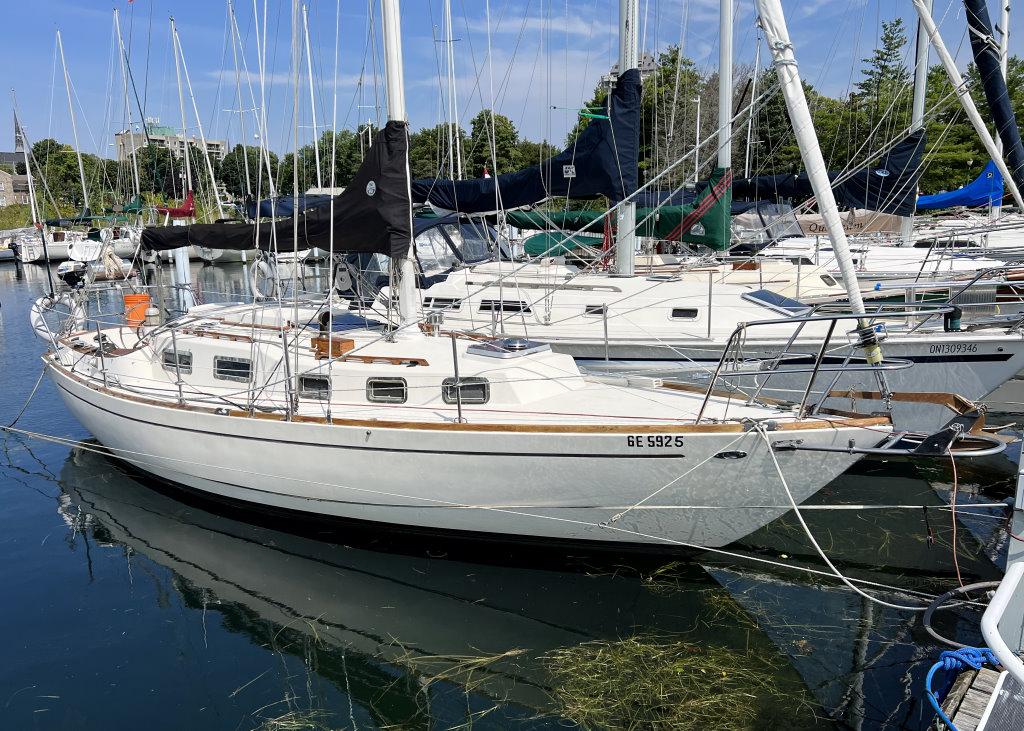
The Alberg 29 was designed by naval architect Carl Alberg and built by Nye Yachts in Canada from 1976 to 1985. The full-keel, masthead sloop was made to replace the much admired Alberg 30, which had been in production since 1962.
The cockpit shape allows unhampered movement forward by the helmsman when single-handed sailing. The cockpit has large, self-bailing drains and seat locker storage. The galley was laid out for safety. The quarter berth on the Alberg 29 was new to Alberg-designed production boats. Four bronze-framed, fixed portlights and six bronze-frame, opening ports provide light and ventilation, as does a Plexiglas opening hatch forward on the coachroof. The boat has no shortage of ventilation down below. The galley has a stainless sink with freshwater pump, insulated icebox, and a gimbaled stove with oven. There are some drawers, cupboards and a dish rack. The boat carries 30 gallons of fresh water. The head is located to port with a counter sink to starboard, where it shares space with a hanging locker.
SEABIRD is a one-owner boat which speaks highly of her care and is nothing short of beautiful. She is overbuilt for safety and seakindliness, and fitted for comfortable cruising. She is a lovely sea boat in excellent condition and looking for a new home.
Specifications
- Length: 29ft
- Builder: Nye Boat Works (CAN)
- Beam: 9' 2"
- Draft: 4' 6"
- Displacement: 9000 lbs
- Hull: Fiberglass
- Status: Active
View Full Details
- Designer: Carl Alberg
- Keel: Full Keel
MEASUREMENTS
- Length Overall: 29 ft
- Length Waterline: 22.25 ft
- Max Draft: 4' 6"
- Displacement: 9000 lb
- Ballast Weight Measure: 4000 lb
- Cabin Head room measure: 6' 0"
- Beam Measure: 9' 2"
- Total Power: 15
- Engine Brand: Yanmar
- Year Built: 1980
- Engine Model: 2QM15
- Engine Type: Inboard
- Engine/Fuel Type: Diesel
- Engine Hours: 1010
- Engine Power: 15 hp
- Fresh Water Tanks: 1 (30 Gallons)
- Fuel Tanks: 1 (12 Gallons)
Accommodations
- Number of cabins: 1
- Number of heads: 1
General Equipment
- Anchor 1: CQR
- Anchor 2: Danforth
- Anchor Chain: 20 feet
- Anchor Rode: 300 feet
- Batteries: 3 Battery Parallel Switch
- Battery Selector Switch
- Bilge Pumps: 1 Manual
- Bilge Pumps: 1 Electric
- Alternator Info: 35 amp plus a spare
- Boarding Ladder
- Bow Roller: custom stainless steel double roller
- Storage Cradle
- Dinghy: 8-foot inflatable
- Dinghy Motor: Honda 2hp
- Head: Manual
- Heater: Built In
- Screens on Hatches and Ports
- Survey Year: 2023
- Teak and Holly Cabin Sole
- 2-burner propane Stove with Oven
Safety Equipment
- Boat Hooks: 2
- Carbon Monoxide Detector
- Fire Extinguishers: 3
- Fume Detector
- Life Jackets: 2
- Radar Reflector
Electronics
- GPS: Handheld
- Depth Sounder
- VHF with DSC
Canvas Info
- Colour: Blue
- Dodger: Frame only
- Mainsail Cover
Sails and Rigging
- Keel Type: Full
- Spar Material: Aluminum
- Rigging: SS Wire
- Main: Full-batten in good condition
- Headsail 1: 150% Genoa
- Headsail 2: 130 % genoa 9 oz. triple-stitched
- Roller Furling
- Back Stay Adjuster
- Boom Vang: Walder Boom Brake
- Snatch Blocks: 2
- Spreader Lights
- Topping Lift
- Winches Standard: 4
- Winches Self-Tailing: 2
- Winch Handles: 2
- Whisker Poles: 2
- Wheel Steering
Disclaimer The Company offers the details of this vessel in good faith but cannot guarantee or warrant the accuracy of this information nor warrant the condition of the vessel. A buyer should instruct his agents, or his surveyors, to investigate such details as the buyer desires validated. This vessel is offered subject to prior sale, price change, or withdrawal without notice.
SEABIRD | Alberg 29 Sloop 29ft
- CAD$ 19,900

- Grant and Pat Bowlby
Mobile: 613-331-5944

Request More Information

Alberg 29 Sloop
Broker: Grant and Pat Bowlby 613-331-5944 Or send us a message about this boat
Share this Boat
More Information
Featured Listings

Canadian Sailcraft CS 30
- CAD$ 30,000

- Brockville, ON
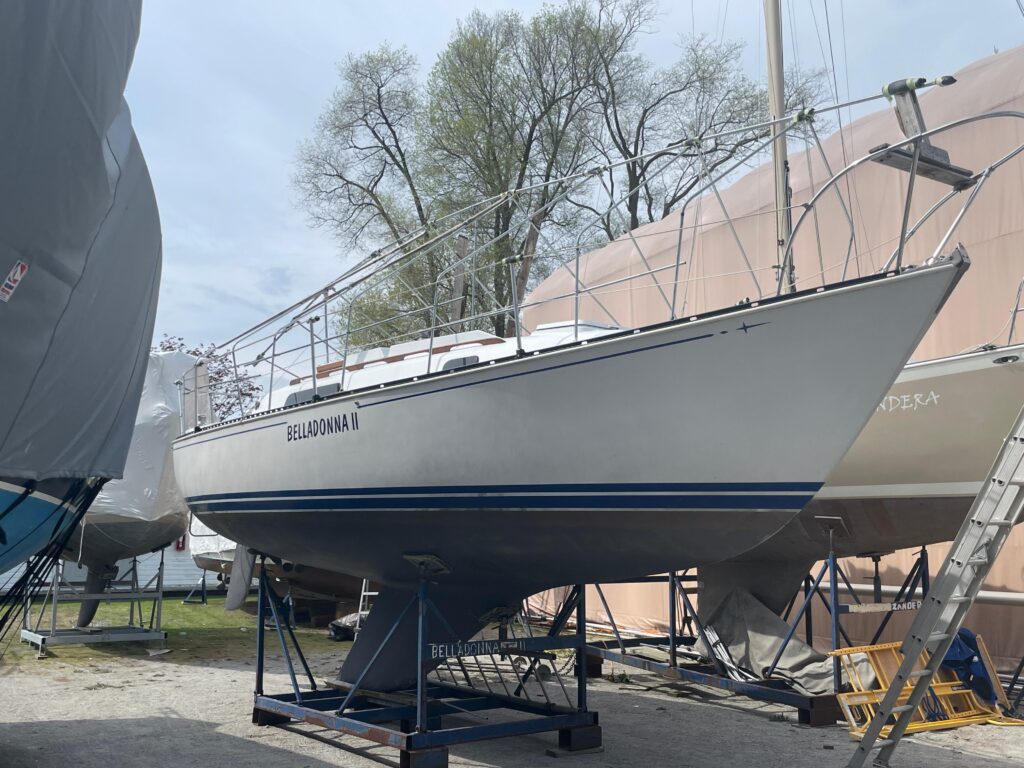
C&C 30 MkI
- Toronto, ON
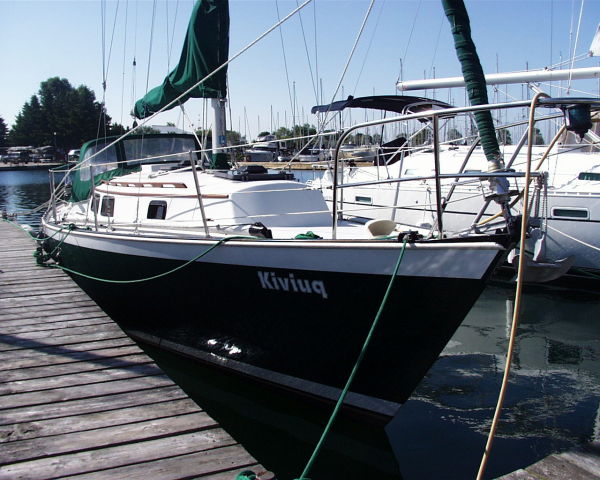
Hinterhoeller Niagara 31
- CAD$ 25,000
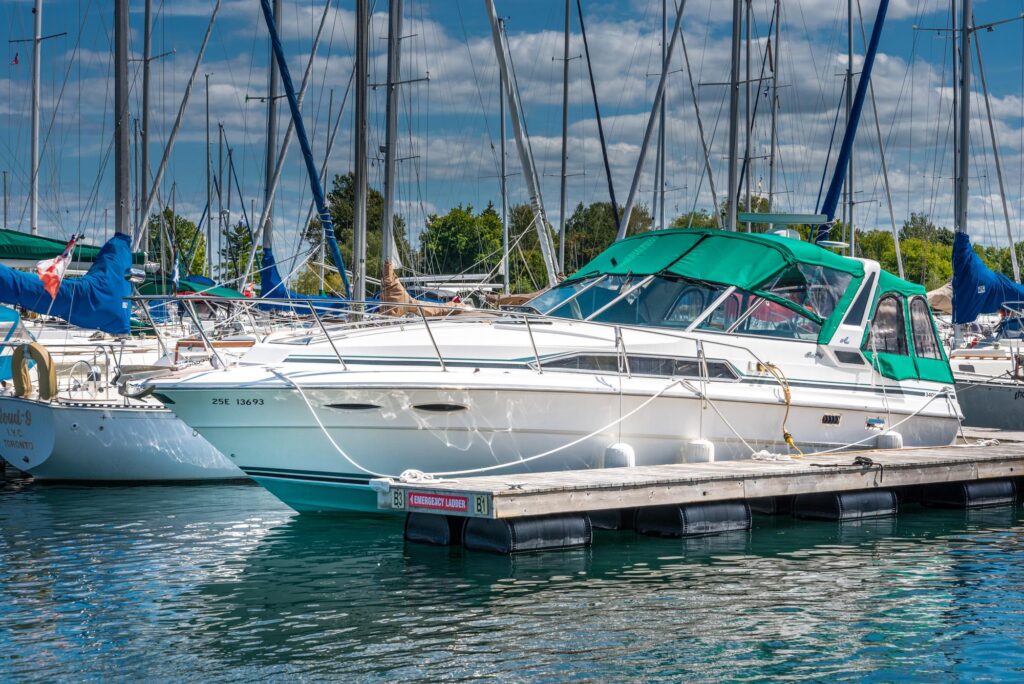
Sea Ray 340 Sundancer
- Thornbury, ON
- CAD$ 47,900
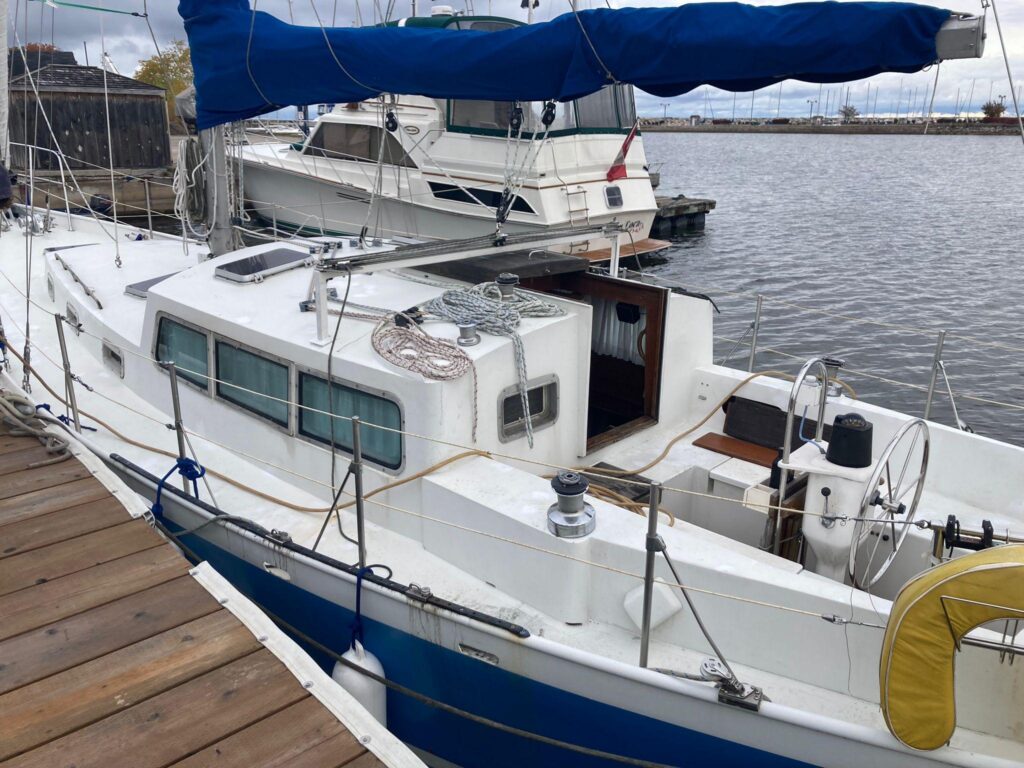
Brewer Pilothouse Cutter
- Hamilton, ON
- CAD$ 55,000

Our Latest from Instagram
- Lake Ontario and...
- Dave Harris
- 416-562-4856
- [email protected]
- Thousand Islands, Rideau Waterway and Eastern Ontario
- 613-331-5944
- [email protected]
- Georgian Bay
- Ewan Campbell
- 705-529-9433
- [email protected]
- South Western Ontario
- George Ayers
- 226-932-6974
- [email protected]
- Lake Simcoe, Toronto and the GTA
- John Heintzman
- 416-435-5029
- [email protected]
- Western Georgian Bay and Bruce Peninsula
- 226-791-2881
- [email protected]
- Southwestern Ontario
- 519-751-9656
- [email protected]

© 2024 Harris & Ellis Yachts. All Rights Reserved
Types of Sailboats: Essential Guide for Every Sailor
Sailboats have been an essential part of human history, contributing to exploration, trade, and leisure. With a myriad of designs and sizes, these versatile vessels cater to various purposes and preferences. The defining characteristics of sailboats come from their rigging, sails, and hull design.
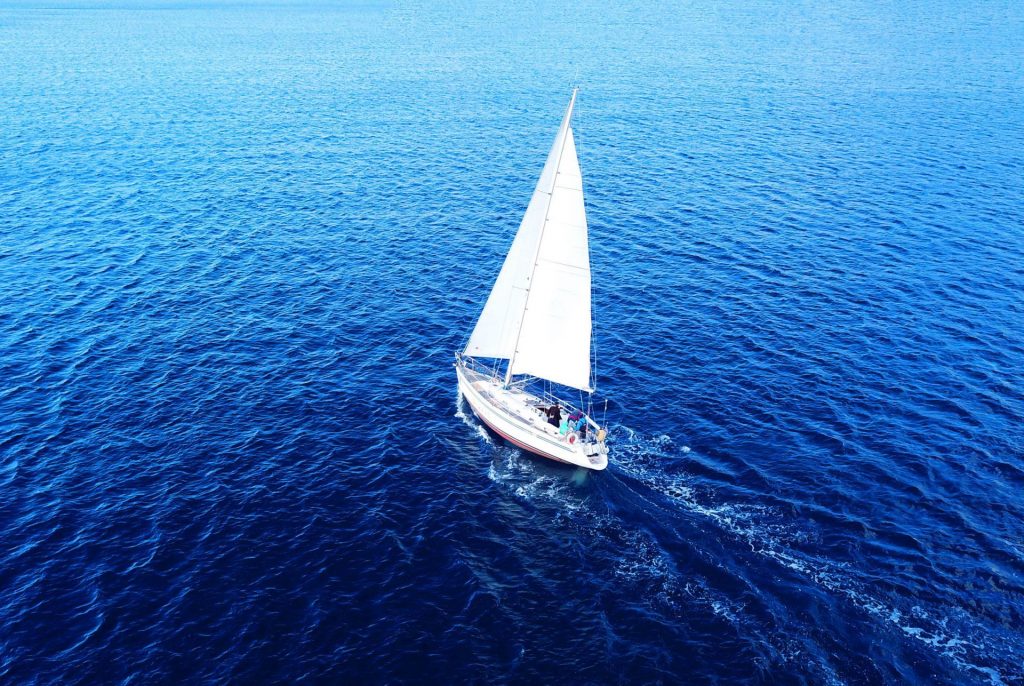
The basics of sailboat design play a significant role in the classification and function of these vessels. Hull shapes, keel types, and construction materials contribute to the speed, stability, and maneuverability of sailboats. Additionally, rigging and sails come in various shapes and sizes, which influence sailing performance and handling.
Key Takeaways
- Sailboats are classified by hull design, rigging, and sails that serve specific purposes.
- Designs and materials have a direct impact on the performance and handling of sailboats.
- A wide range of sailboat types exists, which cater to different needs and preferences.
Basics of Sailboat Design
Sailboats come in various shapes and sizes, designed for different purposes and sailing conditions. One can classify sailboats based on hull types, keel types, and mast configurations. This section will briefly discuss these basic components of sailboat design.
There are mainly two types of hulls: monohull and multihull.
- Monohull : This is the traditional and most common type of sailboat hull. It consists of a single hull, providing stability through the use of a keel or centerboard. Monohulls come in various shapes and sizes, suitable for various sailing conditions.
- Catamaran : Catamarans have two parallel hulls of equal size, offering increased stability and speed compared to monohulls. They are commonly used for cruising and racing.
- Trimaran : Trimarans have three hulls, with a larger central hull and two smaller outrigger hulls. This design offers even more stability and speed than catamarans.
The keel is an essential component in sailboat design, helping with stability and performance. There are various keel types, including:
- Full keel : This traditional design features a long and wide keel that extends along the boat's bottom. It offers good tracking and stability but sacrifices speed and maneuverability.
- Fin keel : Fin keels are shorter and deeper than full keels, providing a better combination of stability and maneuverability. These are common in modern monohull sailboats.
- Bulb keel : A bulb keel features a fin keel with a heavy bulb at the bottom, which concentrates the boat's weight, increasing stability and performance in rough conditions.
- Swing keel or centerboard : Swing keels and centerboards can be raised or lowered, allowing the boat to adapt to different water depths and sailing conditions. They are common in smaller boats and racing sailboats.
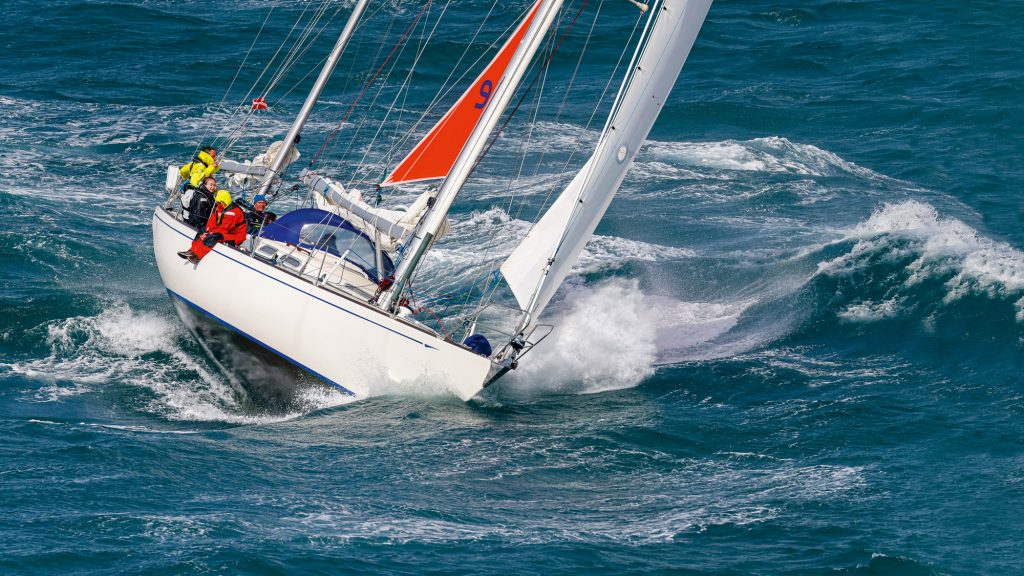
Mast Configuration
The mast configuration affects the sail plan and overall performance of a sailboat. Some common mast configurations include:
- Sloop : This is the most popular mast configuration and features a single mast with a mainsail and a headsail. The simple design makes it easy to handle and suitable for various sailing conditions.
- Cutter : Similar to the sloop, the cutter also has a single mast but carries two headsails, providing more sail area and better performance in heavy weather.
- Ketch : A ketch configuration has two masts: a taller main mast and a shorter mizzen mast. This design offers more flexibility in sail combinations and better balance in different sailing conditions.
- Yawl : Similar to a ketch, a yawl also features two masts but the mizzen is located further aft and is smaller. This design provides better balance and control, particularly in downwind sailing scenarios.
In conclusion, the basics of sailboat design involve selecting the appropriate hull type, keel type, and mast configuration for the desired sailing performance and conditions. Understanding these concepts can help sailors make informed decisions when choosing a sailboat or planning their sailing adventures.
Rigging and Sails
When it comes to sailboats, the rigging and sails play a crucial role in the boat's overall performance and capabilities. This section will briefly cover popular rig types and sail types seen on different sailboats.
There are several types of rigs commonly found on sailboats:
- Sloop : Sloops are the most common type of rig found on modern sailboats. They have a single mast with a mainsail and a single headsail, typically a genoa or jib.
- Ketch : Ketches have two masts, with the main mast taller than the mizzen mast situated aft. They carry a mainsail on the main mast and a mizzen sail on the mizzen mast. Ketches benefit from easier handling and reduced sail area under strong winds.
- Yawl : Similar to ketches, yawls have two masts, but the mizzen mast is smaller and sits further aft, behind the rudder post. Yawls are often chosen for their graceful appearance and improved balance.
- Schooner : Schooners have two or more masts, with the aft mast(s) typically taller than the forward mast(s). Schooners can handle more sails, offering increased sail area for better performance, especially downwind.
- Catboat : Catboats are single-masted sailboats with a single, large mainsail and no headsails. They have a wide beam, which provides stability and ample space for passengers.
- Cutter : Cutters are similar to sloops but carry two headsails, usually a jib and staysail. Cutters may have multiple headsails for increased versatility in various wind conditions.
In addition to the types of rigs, there are also several types of sails used on sailboats, including:
- Mainsail : The primary sail attached to the back of the main mast. It is typically raised on a track or luff groove and managed by a combination of halyard, sheet, and boom vang.
- Genoa : A large triangular sail that overlaps the mainsail, typically used in light winds to provide additional surface area for better performance.
- Jib : A smaller, non-overlapping triangular sail attached to the forestay. Jibs are easier to manage than genoas and are used in a variety of wind conditions.
- Spinnaker : A large, lightweight sail used primarily for downwind sailing . Spinnakers are often brightly colored and shaped like a parachute to catch wind efficiently.
- Staysail : A smaller sail typically used in cutter rigs, positioned between the main mast and the forestay. Staysails provide additional sail area and versatility in varied wind conditions.
Understanding the relationship between sail and rigging can help sailors optimize the performance of their sailboats. With various options for rig types and sail types, each sailboat can be configured to meet the unique needs of its skipper and crew.
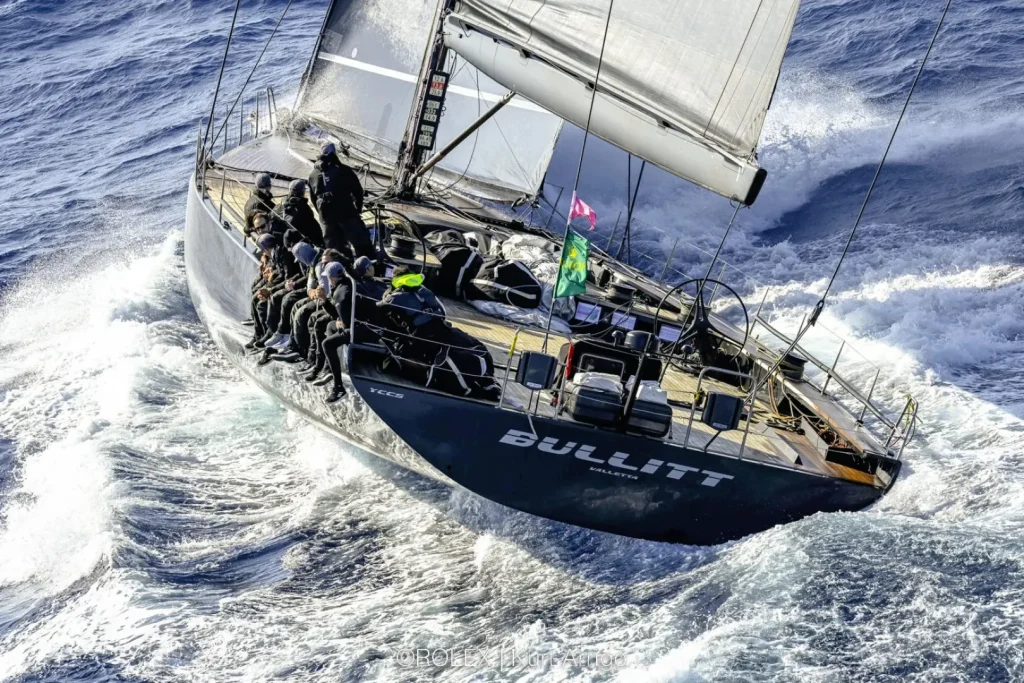
Classes and Types of Sailboats
Monohulls are the most common type of sailboats, consisting of a single hull that provides stability and balance. They come in various sizes and designs, depending on their intended use. Some popular monohull sailboats include the Optimist , Finn, and Sunfish, which are frequently used for racing and recreational sailing. Monohulls tend to have a deeper draft, requiring more water depth than their multi-hull counterparts.
Multihulls, also known as multi-hull sailboats, are a more modern innovation in sailing. They feature two or more hulls connected by a frame or bridgedeck. This design offers increased stability and speed over monohulls. Some common types of multihulls are catamarans (with two hulls) and trimarans (with three hulls). Due to their wider beam and shallower draft, multihulls are particularly suitable for cruising in shallow waters and provide more living space on board.
One-Design Sailboats
One-Design sailboats are a specific class of racing sailboats in which all boats are built to the same design specifications, ensuring that the competition focuses on the skill of the sailor rather than the design of the boat. These boats must adhere to strict rules and standards, with minimal variations allowed in terms of hull shape, sail area, and rigging. Some popular one-design sailboats include the Enterprise and the aforementioned Optimist and Finn sailboats.
Dinghies and Skiffs
Dinghies and skiffs are small, lightweight sailboats that are often used for sailing classes, short-distance racing, or as tenders to larger boats. Dinghies usually have a single mast with a mainsail and sometimes a small jib. Some popular types of sailing dinghies include the Optimist, which is specifically designed for children, and the versatile Sunfish sailboat. Skiffs, on the other hand, are high-performance sailboats primarily used for racing. They have a larger sail area relative to their size and typically include features such as trapezes and planing hulls, which allow for faster speeds and greater maneuverability.
In conclusion, there are various classes and types of sailboats, each with its own unique features and characteristics. From the simplicity of monohulls to the stability and speed of multihulls, and from the fair competition of one-design sailboats to the excitement of dinghies and skiffs, there is a sailboat to satisfy every sailor's preferences.
Sailboat Size and Use
When exploring the world of sailboats, it's important to understand their different sizes and purposes. Sailboats can be categorized into three main types, each with unique characteristics and uses: Day Sailers , Racing Sailboats, and Cruising Sailboats .
Day Sailers
Day Sailers are small sailboats typically ranging from 10 to 24 feet in length. These boats are perfect for short sailing trips and are easy to maneuver for beginners. They have limited accommodations on board, providing just enough seats for a small group of people. Some popular day sailer models include the Laser, Sunfish, and Flying Scot. Lightweight and agile, Day Sailers are often used for:
- Recreation: casual sailing or exploring nearby waters with family and friends
- Training: beginner sailing lessons or practicing sailing techniques
- Competition: local club races or interclub regattas
Racing Sailboats
Racing Sailboats are designed to provide maximum speed, maneuverability, and efficiency on the water. Sizes may vary greatly, from small dinghies to large yachts. Key features of racing sailboats include a sleek hull shape, high-performance sails, and minimalistic interiors to reduce weight.
Career racers and sailing enthusiasts alike participate in various types of racing events , such as:
- One-design racing: all boats have identical specifications, emphasizing crew skill
- Handicap racing: boats of different sizes and designs compete with time adjustments
- Offshore racing: long-distance racing from one point to another, often around islands or across oceans
Cruising Sailboats
Cruising Sailboats are designed for longer journeys and extended stays on the water. They typically range from 25 to 70 feet in length and provide comfortable accommodations such as sleeping cabins, a galley, and storage spaces for supplies and equipment. Sailing cruisers prioritize stability, comfort, and durability for their voyage.
Here are some common types of cruising sailboats:
- Cruiser-racers: These boats combine the speed of a racing sailboat with the comfort and amenities of a cruising sailboat. They are ideal for families or sailors who enjoy participating in racing events while still having the option for leisurely cruises.
- Bluewater cruisers: Designed for handling the world's most demanding ocean conditions, bluewater cruisers are built with a focus on sturdy, self-reliant sailboats that can withstand long-distance voyages and challenging weather conditions.
- Multihulls: Catamarans and trimarans are gaining popularity in the cruising world for their typically more spacious interiors and level sailing characteristics. With two or three hulls, multihulls offer high levels of stability and speed for a comfortable cruising experience.
Understanding the differences between various sailboat types will help potential sailors select the perfect vessel for their sailing goals, skills, and preferences. Day Sailers, Racing Sailboats, and Cruising Sailboats each have their unique features, catering to distinct uses and sailing experiences.
Advanced Sailboat Features
Sailboats have evolved over time, and many advanced features have been developed to enhance performance and safety. In this section, we will discuss some of the key advanced features in modern sailboats, focusing on performance enhancements and safety/navigation.
Performance Enhancements
One critical component that impacts a sailboat's performance is the type of keel it has, which affects stability, resistance, and maneuverability . There are several kinds of keels such as fin keel , wing keel , and bulb keel . Fin keels offer low drag and high efficiency, making them suitable for racing sailboats. On the other hand, wing keels provide better stability at low speeds, while bulb keels provide a lower center of gravity to enhance overall stability and comfort during long voyages.
Another feature that contributes to a sailboat's performance is its sails and rigging. The jib is a triangular sail at the front of the boat, which helps improve its upwind performance. More advanced sailboats use a combination of shrouds , which are the supporting cables running along the sides of the boat, and stays , the cables that help hold the mast in place, to create a stable and efficient rigging system.
A sailboat's performance can also be influenced by the presence of a centerboard or daggerboard , which can be adjusted to optimize stability, maneuverability, and speed. When racing or navigating in shallow waters, retractable centerboards and daggerboards are particularly useful as they provide better performance and versatility.
Safety and Navigation
Safety and navigation onboard a sailboat relies on a combination of advanced gear and equipment. A modern sailboat is usually equipped with:
- GPS and chartplotters to assist with navigation and planning routes
- VHF radios for communication with other vessels and authorities
- Radar to detect obstacles, weather systems, and other vessels
- AIS (Automatic Identification System) which helps monitor nearby vessel traffic
The design of a sailboat's hull, rigging, sails, and hardware also contribute to its safety. The boom , the horizontal pole that extends the sail, should be properly secured and designed to avoid accidents while sailing. The keel , whether it's a fin, wing, or bulb keel, plays a vital role in the overall stability and safety of the sailboat. The choice of keel should be based on the intended use of the sailboat and the prevailing sailing conditions.
In summary, advanced sailboat features significantly improve the performance, safety, and navigation capabilities of modern sailboats. Innovations in keel design, rigging systems, and onboard navigational equipment have undoubtedly contributed to the overall enjoyment and safety of sailing.
Sailboat Ownership
Buying Considerations
When considering buying a sailboat , it is important to understand the different types of sailboats available and the purpose each serves. Sailboats can be broadly categorized into three types:
- Racing sailboats: Designed for speed and performance, with minimalistic interiors and advanced sail systems.
- Cruising sailboats: Built for comfort and longer trips, featuring more spacious interiors and amenities.
- Daysailers: Smaller, easy-to-handle boats that are often used for short trips and recreational sailing.
Prospective boat owners should consider factors such as boat size, type, budget, and intended use (solo vs. family sailing, charter operations, etc.). It's also essential to evaluate the availability of necessary gear and the level of experience required to handle the chosen sailboat.
Maintenance and Upkeep
Sailboat ownership involves maintenance and upkeep to ensure the boat remains functional, safe, and holds its value. Some common maintenance tasks include:
- Hull cleaning and inspection: Regularly inspect the hull for damages and clean off any growth to maintain performance and fuel efficiency.
- Antifouling paint: Apply antifouling paint to prevent marine organisms from attaching to the hull, which can negatively impact the boat's performance.
- Engine maintenance: Check and replace engine oil, inspect cooling and fuel systems, and clean or replace air filters.
In addition to regular maintenance, sailboat owners should also be prepared to replace or repair critical systems and components, such as:
- Sails: Monitor the condition of your sails and replace them as needed to maintain performance and safety.
- Rigging: Regularly inspect and maintain the standing and running rigging, and replace worn or compromised parts.
- Electronics and instruments: Ensure navigation systems, radios, and other electronic equipment are functioning properly.
Taking proper care of a sailboat can be time-consuming, and some owners may choose to charter their boats when not in use as a way to offset ownership costs. Others may opt for hiring professionals to manage routine maintenance, particularly when sailing solo or with limited sailing experience.
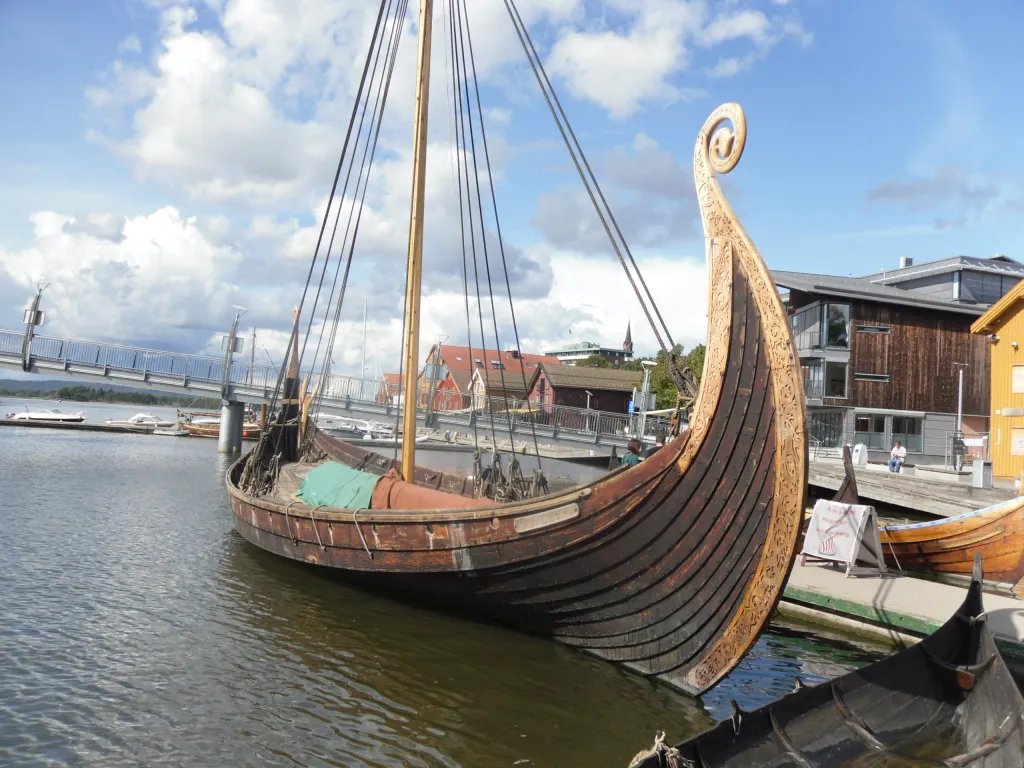
Historical and Special Sailboats
Tall ships and gaffers.
Tall Ships are large, traditionally rigged sailing vessels with multiple masts, typically square-rigged on at least one of their masts. Some examples of these ships include the clipper, brig, and square-rigged vessels. The clipper is a fast sailing ship known for its sleek hull and large sail area, while the brig features two square-rigged masts. Square-rigged ships were known for their impressive sail area and could cover large distances quickly.
Gaffers are a subset of historical sailing vessels with a gaff mainsail as their primary sail type. This gaff-rig is characterized by a spar (pole) that extends the top edge of the mainsail, giving it a quadrilateral shape to optimize wind coverage. Gaff mainsails were commonly used in England and influenced the development of other sailing vessels.
Classic and Antique Sailboats
Classic and antique sailboats refer to older, traditionally designed sailing vessels that have been preserved or restored. They often feature wooden construction and showcase a variety of rigging types, including gaff rigs and square rigs. These historical sailboats have unique designs, materials, and techniques that have since evolved or become rare.
Here are some examples of antique and classic sailboats:
- Sloop : A single-masted sailboat with a Bermuda rig and foresail
- Cutter : A single-masted vessel with a similar rig to the sloop, but with additional headsails for increased maneuverability
- Ketch : A two-masted sailboat with a smaller mizzen mast aft of the main mast
In summary, historical and special sailboats encompass a wide range of vessel types, from large, multi-masted tall ships to smaller, single-masted gaffers and classic sailboats. These vessels reflect the rich maritime history and the evolution of sailing techniques and designs over time.
Sailboat Culture and Lifestyle
Sailboat culture and lifestyle encompass a variety of aspects including racing events, leisurely cruising, and exploring new destinations. The main types of sailboats include racing yachts, cruising sailboats, and motorsailers, each offering a unique experience for sailors.
Regattas and Racing Circuits
A popular aspect of sailboat culture involves participating in regattas and racing circuits . These events create a competitive atmosphere and develop camaraderie among sailors. Racing sailboats are specifically designed for speed and agility , and sailors often team up to compete in prestigious races such as the Rolex Sydney Hobart Yacht Race or the America's Cup. Yacht clubs play an essential role in cultivating this competitive sailing environment.
Sailboat Charter and Tourism
Another facet of sailing culture is the sailboat charter and tourism industry, which allows people to experience the cruising lifestyle without owning a sailboat. Charters are offered for various types of sailboats, from family-sized cruising vessels to luxurious superyachts . Yacht sailing provides tourists with a unique travel experience, as they can explore diverse destinations, immerse themselves in local cultures, or simply relax on the open water.
Cruising sailboats are designed to provide comfortable living spaces and amenities, making them perfect for longer journeys or exploring remote destinations. Motorsailers, on the other hand, are equipped with both sails and engines, offering versatility and convenience for sailors.
Some popular sailing destinations include the Caribbean, Mediterranean Sea, and the South Pacific. These regions offer beautiful scenery, rich cultural experiences, and ideal sailing conditions.
The sailboat culture and lifestyle attract individuals who enjoy adventure, exploration, and camaraderie. From competitive racing events to leisurely cruising vacations, sailing offers diverse experiences that cater to a wide range of interests.
Frequently Asked Questions
What are the distinguishing features of different sailboat classes?
There are various sailboat classes, each with its own distinguishing features. Monohulls, for example, are the most common type of sailboat and have a single hull. Multihulls, such as catamarans and trimarans, have two or three hulls, respectively. These differences in hull design often affect the boat's stability, speed, and maneuverability.
Which sailboat types are best for novice sailors?
Novice sailors often benefit from starting with smaller, more manageable boats. Sailing dinghies and daysailers are popular choices due to their simple rigging and ease of handling. These boats typically have a single mast and a limited number of sails, making them ideal for beginners to learn sailing basics.
What are common types of small sailboats ideal for day sailing?
For day sailing, small sailboats such as sailing dinghies, day sailers, and pocket cruisers are ideal options. These boats usually range between 12 and 25 feet in length and offer simplicity, ease of handling, and portability. Examples of common day sailing boats include the Sunfish, Laser, and O'Day Mariner.
How do the purposes of various sailboat types vary?
Sailboats serve different purposes based on their design, size, and features. Daysailers and dinghies are ideal for short trips, sailing lessons, and casual outings. Racing sailboats, with their lighter weight and streamlined design, are built for speed and competition. Cruising sailboats, on the other hand, are designed for longer voyages and often include living quarters and additional amenities for comfortable onboard living.
What is considered the most popular class of sailboat for recreational use?
The most popular class of sailboat for recreational use often varies depending on individual preferences and local conditions. However, monohulls are commonly preferred due to their widespread availability, versatility, and affordability. Within the monohull class, boats like the Sunfish, Laser, and Catalina 22 are popular choices for their ease of use and adaptability to various sailing conditions.
Could you describe a sailing dinghy designed for two people?
A two-person sailing dinghy typically has a simple rig with a single mast and one or more sails, making it easy to handle for both experienced and novice sailors. The RS Venture , for example, is a popular choice for two-person sailing. It features a spacious cockpit, durable construction, and simplicity in its rigging and control systems. These characteristics make it an excellent option for recreational sailing, training, and even racing.
Related Articles
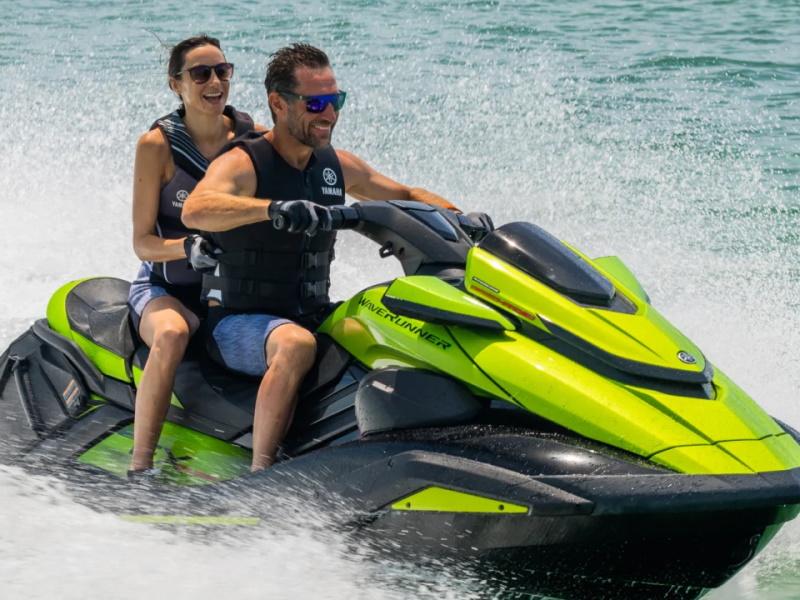
Which Action May Cause Loss of Steering Ability in a PWC? Essential Safety Tips
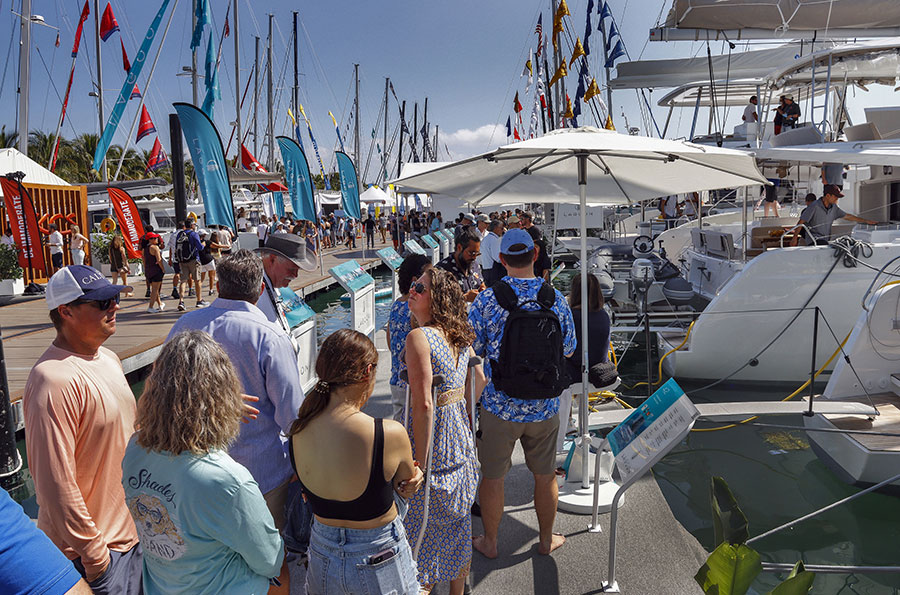
Boat Shows - A Complete List: Comprehensive Guide to All Events
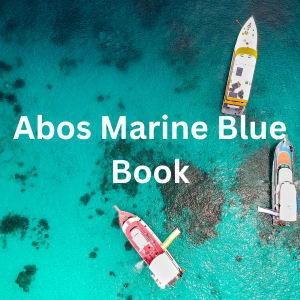
Abos Marine Blue Book: Ultimate Guide to Mastering Boat Valuation and More
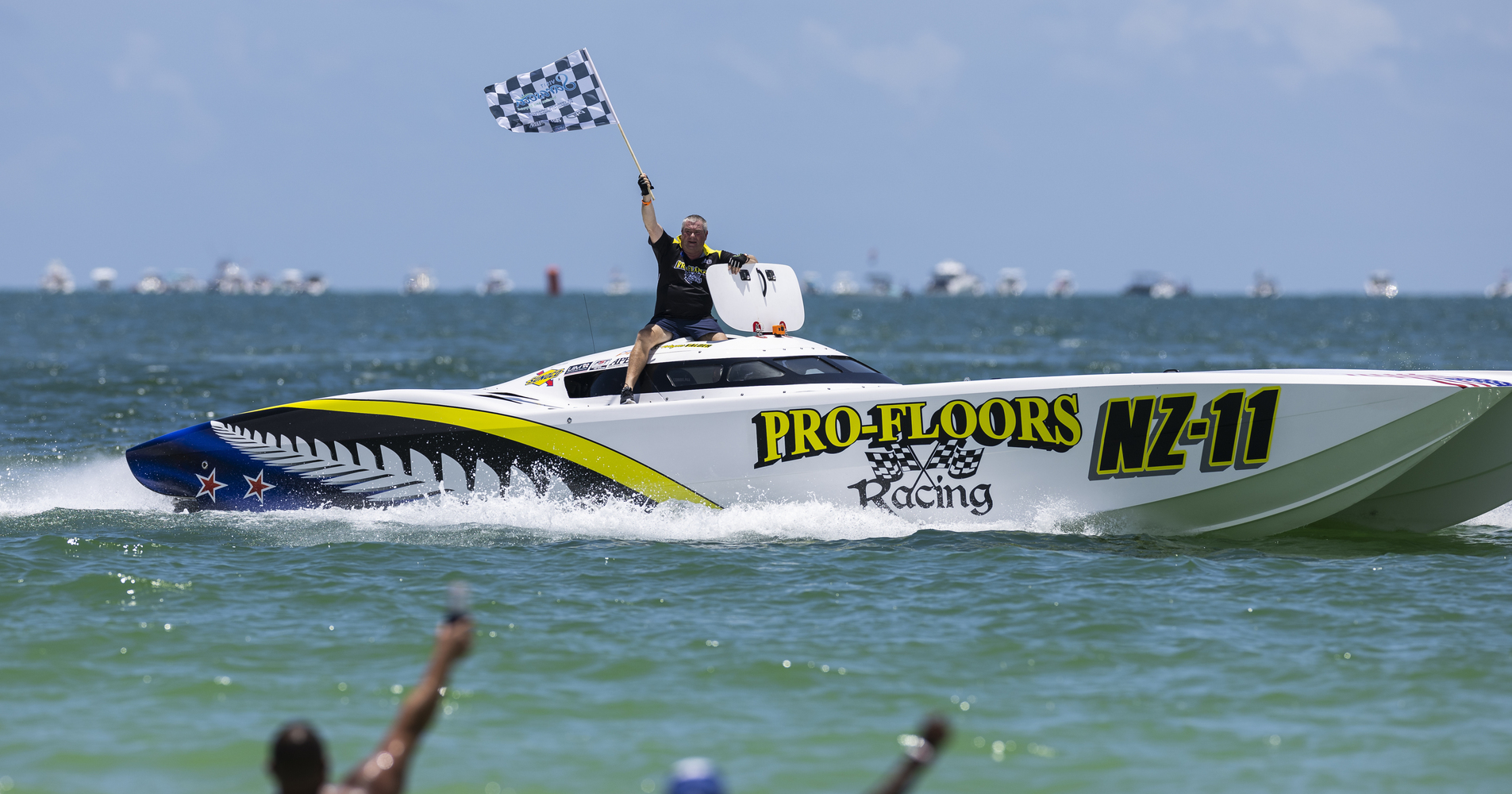
Sarasota Boat Races 2023: A Thrilling Preview of Upcoming Events
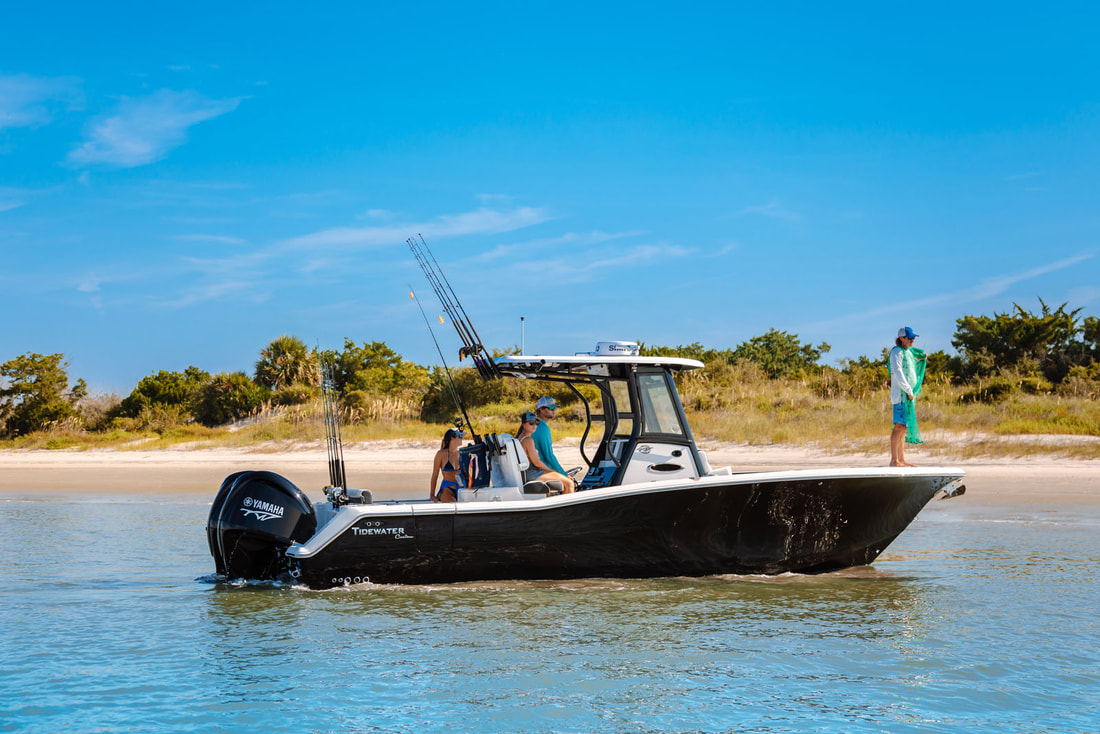
Tidewater Boats 2024: Unveiling the Latest Models and Features
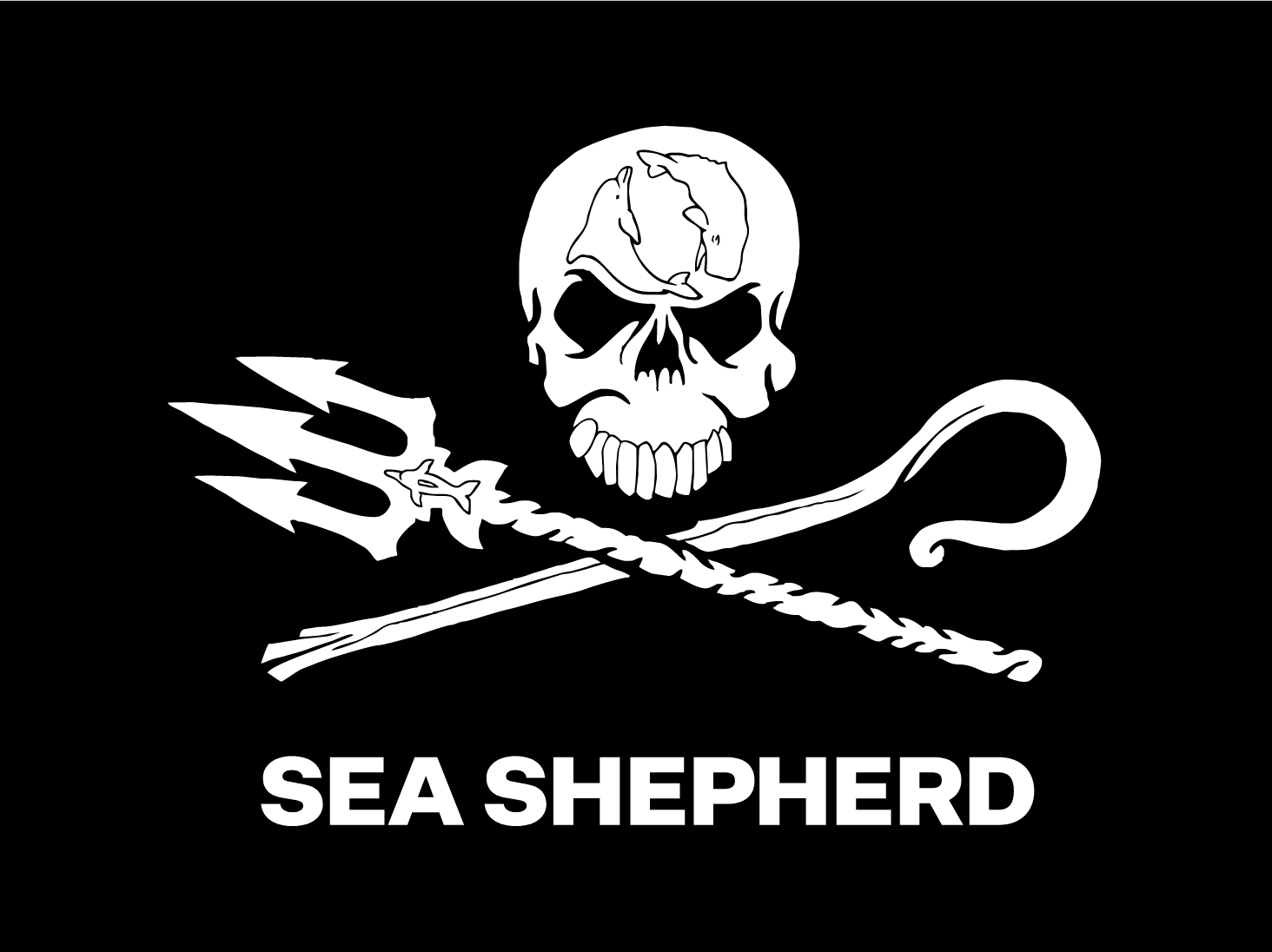
Eating Vegan on the Ocean Conservation Ship Sea Shepard: A Sustainable Journey at Sea

Regal Boats: A Comprehensive Guide to Luxury on the Water
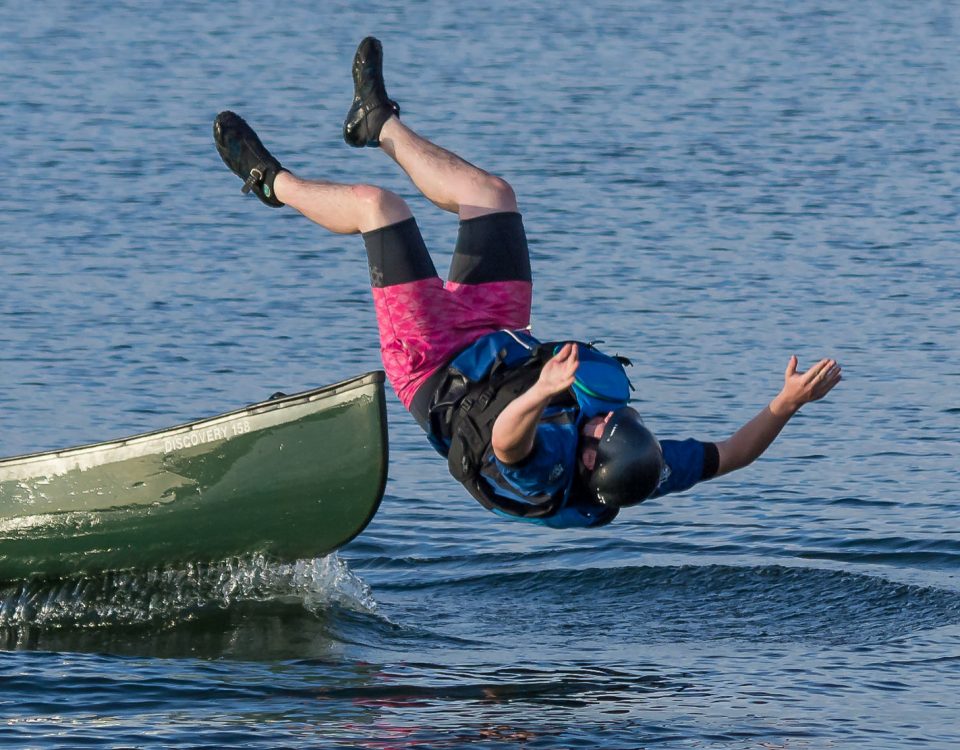
A Passenger on a Small Boat Falls Overboard: How to Safely Pull Them Back Aboard
- Share full article
Advertisement
Supported by
In Maine, a Father-Daughter Team Wins a Lobster Boat Race
Jeremy Beal, a boat builder and lobsterman, had a simple strategy: “Point it and punch it!” His 14-year-old daughter took it from there.

By Steven Kurutz
Reporting from Long Island, Maine.
Dozens of boats zipped across Casco Bay during the Maine Lobster Boat Races on Saturday. Only one had a purple bottom.
That boat, a 32-footer with a powerful diesel engine, belonged to Jeremy Beal, 45, a large, soft-spoken man who comes from a long line of boat builders and lobstermen.
“See, I grew up right in it,” he said between drags of a cigarette while leaning against the rail of his boat on the evening before the big race.
For decades, Mr. Beal’s father, Wayne Beal, and an uncle, Calvin Beal, have built boats used by commercial fishers up and down the Maine coast. After years spent learning the family trade, Jeremy took over his dad’s business, Wayne Beal’s Boat Shop, in Jonesport, a seaside town more than 200 miles northeast of Portland.
“I bought the boat off my father,” Mr. Beal said. “It was his last power boat. He’s retired out of the boat shop. I won’t sell the boat unless I have to. Just for the fact that it was my dad’s.”
To pay off the boat, Mr. Beal has returned part-time to lobster fishing, something he first started doing at age 6. This summer he has been helped by his 14-year-old daughter, Mariena Beal, who will enter ninth grade at Jonesport-Beals High School next month.
Together, father and daughter have been dropping 250 traps into the Gulf of Maine to catch thousands of the large lobsters prized around the world for their meat. They split whatever money is left after paying for the bait (herring, mostly), fuel and the monthly boat bill.
Mr. Beal said he hoped the experience would teach his daughter both financial responsibility and the family’s way of life on the water. But Mariena didn’t quite get her way when it came to the color of the boat.
“She wanted a pink bottom, but I wouldn’t let that fly,” he said.
The pair hit on purple as a compromise. And Mariena got to name the boat — My Turn, she called it.

When they are not hauling up traps, Mr. Beal and his daughter have been competing on the lobster boat racing circuit, an annual series of summertime competitions along the Maine coast. The events, run by the Maine Lobster Boat Racing Association, are essentially drag races — the fastest boat wins.
“I’ve always been a competitor,” Mr. Beal said.
He summarized his racing strategy: “Point it and punch it!”
Two days before the recent race, Mr. Beal unloaded the buckets of herring he keeps on deck. He lugged out the lobster crates and the 55-gallon plastic drums that store the catch. Finally, he took a scrub brush and washed down the deck with Dawn dish soap.
On Friday morning, after waking early and packing sandwiches for lunch, Mr. Beal charted a scenic southwesterly course south from Jonesport. Alone on deck, he took in the sight of the rocky coastline and marine life, including porpoises. His wife and daughters, including Mariena, drove the 200 miles separately in a car.
It took Mr. Beal just under five hours to sail to Long Island, one of Maine’s Casco Bay islands that lie a few miles from Portland. Many of its 230 residents work on boats or own one.
A crowd had gathered for a cookout at the old boathouse on Wharf Street when Mr. Beal moored his vessel. Men and women were eating hamburgers, drinking beer and lining up to buy race merchandise from Lisa Kimball, an islander who co-chairs the race. The proceeds were going toward a scholarship fund for children on the island.
Mr. Beal made the rounds. Several of the partygoers had bought their boats from him or his father. The price of lobsters was solid this year, everyone agreed, though the catch varied from “good” to “horrible,” depending on who you asked.
Adam Kimball, Ms. Kimball’s husband, planned to race the next day. He works on an oil tanker in Alaska, but you don’t need a commercial fishing license to compete — so long as you have a typical lobster boat, which he does.
“It’s a lot of money to spend for not a lot of return,” Mr. Kimball, 46, said with a laugh.
He was referring to the modest prize money, usually a few hundred dollars, and to the way some boat owners invest thousands to gain horsepower and perhaps a knot or two in speed.
“They call it ‘gooning up’ the engine,” Mr. Kimball said. “There are some risks to that. Like you blow it up.”
Mr. Beal spotted one of the modern legends of the lobster boat racing.
“Stevie Johnson,” he said. “Now there’s a real character.”
Mr. Johnson, the proprietor of Johnson’s Boatyard on Long Island, is known for building unusual boats , some with automobiles mounted on the hulls. One of them, the “Vette-Boat,” features a 1984 Corvette on a 28-foot hull. Mr. Johnson has won his share of races on his tricked-out vessels over the years, but their main purpose is “to cause a scene,” he likes to say.
Dressed in a blue Hawaiian-print shirt, blue board shorts and Crocs, and nursing Canadian Club whiskey and ginger ale in a red plastic cup, Mr. Johnson, who is in his 70s, was trailed by a small entourage at the cookout.
It was getting late. Mr. Beal untied his boat and sailed over to Portland, where a friend was letting him dock while in town.
Mariena had missed the cookout — she was at the Maine Mall, the largest shopping plaza in the state, doing some back-to-school shopping with her mother. The next day, she would be at the wheel of My Turn.
“She’s like me,” Mr. Beal said. “She likes to go fast.”
And the Winner Is …
She also likes to shop. Mariena and her family members missed the noonish start time of the races on Saturday because they had gotten stuck in traffic after spending the morning back at the mall.
Mr. Beal stood at the wheel of My Turn, engine idling, listening to an announcer call the first few races over a marine radio.
At quarter to one, Mariena came bounding down the dock and onto the boat. She wore black shorts, a white North Face long-sleeved top and leather sandals. Her toenails were painted purple, matching the color of her nose ring and the bottom of My Turn.
Like her father, Mariena was reserved. Asked what she liked about racing lobster boats, she replied, “Everything.”
She was joined on the boat by her mother, Maria Beal; her boyfriend, Caleb Geel; her older sister, Caitlin Childers; and Caitlin’s boyfriend, Nick Guptill.
Mr. Beal gunned the throttle and sped toward Long Island. By now, dozens of pleasure crafts and lobster boats were on the water. A crowd of spectators stood at the ferry dock.
Mr. Beal pulled up to the large boat where officials kept watch over the day’s races through binoculars. His passengers disembarked, leaving My Turn for the so-called committee boat.
Then Mr. Beal and Mariena motored toward the starting line, which was nearly a mile north. Once they were among the other boats in their race category — the G classification race, for boats from 28 to 35 feet in length with diesel engines — Mariena took the wheel.
The committee boat was like a floating party, with coolers of food and drinks. Jon Johansen, the bearded president of Maine Lobster Racing, and the publisher of Maine Coastal News , which covers the races, used a telephoto lens to call out the action.
On board, Maria Beal told a story.
Well into the time she was pregnant with Mariena, she said, she had done a lot of lobstering with her husband. That meant hauling up heavy traps to the point that she ruptured her placenta. The doctors thought she would lose the baby.
”But I went to bed for two weeks and it healed up,” Maria said. “And that’s why we named her Mariena — it means ‘lover of the sea.’”
It was now time for the G classification race.
The lead boat was a speck on the water. As it came closer, you could make out its purple bottom leaving a white-capped wake and all the other boats behind it.
Mariena had won, easily. The Beal contingent whooped and cheered.
“She doesn’t have much fear,” her mother said. “Never has. She’s been looking for speed since she was born.”
My Turn sidled up to the committee boat. Amy Tierney, a race co-chair, handed over an envelope of prize money. Mariena was $200 richer.
What did she plan to do with her winnings?
She smiled.
Steven Kurutz covers cultural trends, social media and the world of design for The Times. More about Steven Kurutz
Explore Our Style Coverage
The latest in fashion, trends, love and more..
The Most Wanted ‘Girl’ in Fashion: How did Miu Miu become fashion’s biggest success story — halfway to $1 billion in sales for 2024?
Hairstyle Heat Relief: On a hot day, getting hair off the back of your neck is often the simplest way to start cooling down. The sweeping movement is instinctual, but it is also deeply personal.
Putting the Fun in Funerals: Modern, even hip, mortuaries around the world are hoping to answer one question: How do we commemorate death in 2024 ?
A Shoe That Goes 65 M.P.H.: Our reporter and photographer hit the road for a trip from Maine to Massachusetts in L.L. Bean’s Bootmobile , a promotional vehicle that takes the shape of the company’s duck boot.
The Harris-Walz ‘Visual Age’ Gap: They’re the same age, but pundits and voters can’t stop talking about how much older Governor Tim Walz looks than Vice President Kamala Harris. It’s not the only way he seems to be absorbing some of the scrutiny usually heaped on female candidates.

IMAGES
COMMENTS
Across our current listings, the average capacity for sloop sailing vessels is 8 people with a maximum capacity of 18 passengers, and the average length overall (LOA) is 40 feet. The yachts available for sale come in a range of sizes, from 23 feet to 107 feet long. On average, they have a sail area of 686 square feet, but some yachts go as high ...
A sloop is a type of sailboat that has a single mast and a fore-and-aft rig. This means that the sails are positioned parallel to the length of the boat, making it easier for sailors to control the direction of the boat. The simplicity and versatility of the sloop rig make it one of the most popular sailboat rigs in use today.
Gaff rigged sloop, 1899. A sloop is a sailboat with a single mast [1] typically having only one headsail in front of the mast and one mainsail aft of (behind) the mast. [note 1] Such an arrangement is called a fore-and-aft rig, and can be rigged as a Bermuda rig with triangular sails fore and aft, or as a gaff-rig with triangular foresail(s) and a gaff rigged mainsail.
The most common rig types on sailboats. To give you an idea of the most-used sail rigs, I'll quickly summarize some sail plans below and mention the three things that make up their sail plan. Bermuda sloop - one mast, one mainsail, one headsail, fore-and-aft rigged; Gaff cutter - one mast, one mainsail, two staysails, fore-and-aft rigged
A Sloop is a type of sailboat that has a single mast and a fore-and-aft rig. It is one of the most popular sailboat designs and is known for its versatility and ease of use. Sloop boats come in various sizes and configurations, making them suitable for different types of water activities such as racing, cruising, and day sailing.
These sailboats have a minimum total sail area of 77 square feet, a maximum total sail area of 2,249 square feet and an average of 728 square feet. Boat Trader currently has 697 sloop sailboats for sale, including 105 new vessels and 592 used and custom yachts listed by both private sellers and professional boat dealers mainly in United States.
The sailboat sloop is a popular type of watercraft designed to cater to the needs of sailing enthusiasts and adventurers seeking thrilling journeys on the open water. These boats offer a balanced combination of performance, ease of handling, and comfortable accommodations. ... Sailing Preferences: Determine your preferred style of sailing ...
The sloop is a popular sailboat design known for its simplicity and versatility. In this section, we will explore the main features of a sloop, including its mast and sails, and the different rig types commonly used. Mast and Sails. A sloop is a single-masted sailboat with a fore-and-aft rig configuration. This means that the sails are placed ...
Constructed by a wide variety of makers, there are currently 2,301 sloop yachts for sale on YachtWorld, with 327 new vessels for sale, and 1,974 used and custom yachts listed. These vessels are all listed by professional yacht brokerages and new boat dealers, mainly in the following countries: United States, France, Italy, Canada and Spain.
View a wide selection of sloop sail boats for sale in ... the Sun Odyssey 380 features a traditional layout in a contemporary style. Whether overnighting, entertaining, or day sailing, the Sun Odyssey 380, like the 410, 440, and 490, strikes the perfect balance between performance and comfort. ... The generous sail plan is easily handled by the ...
A sloop rigged sailboat refers to a popular type of sailing vessel with one mast and two sails - a mainsail located at the rear (aft) of the mast and a headsail at the front (forward). This configuration allows for efficient wind capture and provides great maneuverability in different wind conditions. 2) The Main Components:
There are two main types of sailing sloops: fore-and-aft rigged sloops and Bermuda rigged sloops. Fore-and-aft rigged sloops have their masts positioned near the center of the vessel, while Bermuda rigged sloops have their masts positioned further back, near the stern (rear) of the vessel. Both types of sloop are easy to sail and offer good ...
one mast. triangular mainsail (called a Bermuda sail) a foresail (also called the jib) fore-and-aft rigged. medium-sized (12 - 50 ft) Fore-and-aft rigged just means "from front to back". This type of rigging helps to sail upwind. Any sailboat with one mast and two sails could still be a sloop.
The most common kind of sailboat is the sloop, as it's simple to operate and versatile. Other common sailboat types include the schooner, cutter, cat, ketch, schooner, catamaran, and trimaran. Other sailboat variations include pocket cruisers, motorsailers, displacement, and shoal-draft vessels. The information found in this article is sourced ...
A sloop sailboat normally has one headsail in front of the boat mast and one mainsail aft behind the mast. This is one of the most common rigged sailboats on the water today, with a fore and aft rig, with the Bermuda rig favored by most sailors. ... This single mast style sailing vessel is favored by racers due to its success while sailing ...
First up, what many of us sail - the Sloop Rig. A sloop rig is a boat with a single-mast and a fore and aft sail configuration. Sloops date back to the early 17 th century but didn't really become popular until the 20 th century. The likely reason for their popularity is their ability to effectively head up wind and how relatively simple ...
Advantages of a Sloop. A sloop is generally faster and sails closer to the wind. Sloops have fewer sails than ketches to buy and maintain. With a sloop, there is less standing and running rigging with one mast, which means there is less to manage and maintain overall. As the most popular contemporary boat, sloops are available in a wide variety.
A sloop is a small sailboat with a single mast and typically two sails, the mainsail and the headsail. Sloops are designed to be easy to operate and handle, making them ideal vessels for one or two people. The smaller size of a sloop also makes it more maneuverable than larger boats, allowing you to explore new areas with ease.
June 17, 2024. Sailboats are powered by sails using the force of the wind. They are also referred to as sailing dinghies, boats, and yachts, depending on their size. Sailboats range in size, from lightweight dinghies like the Optimist dinghy (7'9") all the way up to mega yachts over 200 feet long. The length is often abbreviated as LOA (length ...
The Alberg 29 was designed by naval architect Carl Alberg and built by Nye Yachts in Canada from 1976 to 1985. The full-keel, masthead sloop was made to replace the much admired Alberg 30, which had been in production since 1962. The cockpit shape allows unhampered movement forward by the helmsman when single-handed sailing. The […]
Bayesian was a flybridge sloop designed by Ron Holland and built with a 56 m (184 ft) aluminium hull and a single-masted cutter rig.The 75 m (246 ft) aluminium mast was designed for the yacht and at the time was the world's tallest. The yacht had a lifting keel, allowing its draft to be reduced from 10 m to 4 m. [6] It was the fifth constructed of ten similar vessels from the same designer and ...
For day sailing, small sailboats such as sailing dinghies, day sailers, and pocket cruisers are ideal options. These boats usually range between 12 and 25 feet in length and offer simplicity, ease of handling, and portability. Examples of common day sailing boats include the Sunfish, Laser, and O'Day Mariner.
A gaff rig sailboat hoists a 4-cornered sail, instead of the triangular, 3-cornered Bermuda rig. This rig isn't very common in smaller sailboats anymore, although many older ketch style sailboats did originally have gaff sails. The gaff was popular in the old schooner-type sailboats of the colonial Americas.
Drill 1: On a no-wind day or before you leave the dock, identify all of the boat's lines by name and what they do. E.g., "This is the jib sheet, and it trims the forward sail." Drill 2: If the boat is stored on a stable enough dolly or trailer, choose a light-air day to try pulling up the sail(s) on land and then trimming them. Feeling ...
To pay off the boat, Mr. Beal has returned part-time to lobster fishing, something he first started doing at age 6. This summer he has been helped by his 14-year-old daughter, Mariena Beal, who ...
Ideal for these Sloop boats vary in length from 21ft to 104ft and can carry 4 to 16 passengers. There are a wide range of Sloop boats for sale from popular brands like Catalina, Beneteau and Hunter with 378 new and 2,555 used and an average price of $98,992 with boats ranging from as little as $6,595 and $3,833,771.